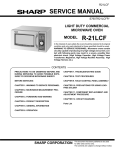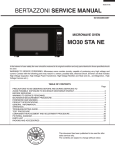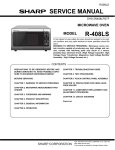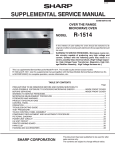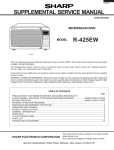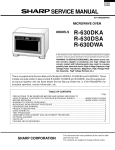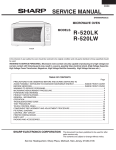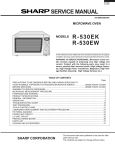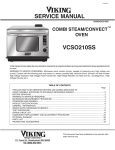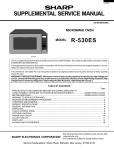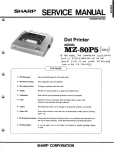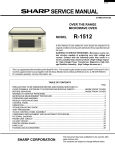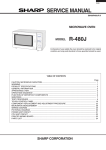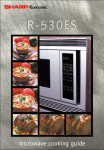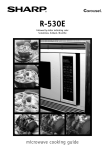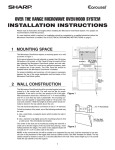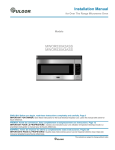Download microwave oven r-530ek-t r-530ew-t r-530es
Transcript
TopPage R530EW SERVICE MANUAL SX705R530EPW/ MICROWAVE OVEN MODELS R-530EW-T R-530EK-T R-530EW-T R-530ES-T R-530ES-T In the interest of user-safety the oven should be restored to its original condition and only parts identical to those specified should be used. WARNING TO SERVICE PERSONNEL: Microwave ovens contain circuitry capable of producing very high voltage and current, contact with following parts may result in a severe, possibly fatal, electrical shock. (High Voltage Capacitor, High Voltage Power Transformer, Magnetron, High Voltage Rectifier Assembly, High Voltage Harness etc..) CONTENTS PRECAUTIONS TO BE OBSERVED BEFORE AND DURING SERVICING TO AVOID POSSIBLE EXPOSURE TO EXCESSIVE MICROWAVE ENERGY CHAPTER 1. WARNING TO SERVICE PERSONNEL CHAPTER 2. MICROWAVE MEASUREMENT PROCEDURE CHAPTER 8. TEST PROCEDURES CHAPTER 9. TOUCH CONTROL PANEL ASSEMBLY CHAPTER 10. PRECAUTIONS FOR USING LEADFREE SOLDER CHAPTER 3. FOREWORD AND WARNING CHAPTER 11. COMPONENT REPLACEMENT AND ADJUSTMENT PROCEDURE CHAPTER 4. PRODUCT DESCRIPTION CHAPTER 12. CIRCUIT DIAGRAMS CHAPTER 5. GENERAL INFORMATION Parts List CHAPTER 6. OPERATION CHAPTER 7. TROUBLESHOOTING GUIDE This document has been published to be used for after sales service only. The contents are subject to change without notice. CONTENTS PRECAUTIONS TO BE OBSERVED BEFORE AND DURING SERVICING TO AVOID POSSIBLE EXPOSURE TO EXCESSIVE MICROWAVE ENERGY CHAPTER 1. WARNING TO SERVICE PERSONNEL [1] Before Servicing.......................................... 1-1 [2] When the testing is completed,................... 1-1 [3] After repairing.............................................. 1-1 CHAPTER 2. MICROWAVE MEASUREMENT PROCEDURE [1] Requirements:............................................. 2-1 [2] Preparation for testing:................................ 2-1 [3] Leakage test: .............................................. 2-1 CHAPTER 3. FOREWORD AND WARNING [1] FOREWORD............................................... 3-1 [2] WARNING................................................... 3-1 [3] DANGER..................................................... 3-1 CHAPTER 4. PRODUCT DESCRIPTION [1] SPECIFICATIONS ...................................... 4-1 CHAPTER 5. GENERAL INFORMATION [1] GROUNDING INSTRUCTIONS.................. 5-1 [2] OVEN DIAGRAM ........................................ 5-1 CHAPTER 6. OPERATION [1] DESCRIPTION OF OPERATING SEQUENCE .................................................... 6-1 [2] OVEN SCHEMATIC .................................... 6-2 [3] DESCRIPTION AND FUNCTION OF COMPONENTS .......................................... 6-3 CHAPTER 7. TROUBLESHOOTING GUIDE CHAPTER 8. TEST PROCEDURES [1] A: MAGNETRON ASSEMBLY TEST .......... 8-1 [2] B: POWER TRANSFORMER TEST ........... 8-1 [3] C: HIGH VOLTAGE RECTIFIER TEST....... 8-1 [4] D: HIGH VOLTAGE CAPACITOR TEST..... 8-2 [5] E: TEMPERATURE FUSE OR THERMAL CUT-OUT TEST ................................. 8-2 [6] F: SECONDARY INTERLOCK SWITCH AND PRIMARY INTERLOCK SYSTEM TEST........................................................... 8-2 [7] G: MONITOR SWITCH TEST ..................... 8-3 [8] H: BLOWN MONITOR FUSE TEST ........... 8-3 [9] I: NOISE FILTER TEST .............................. 8-4 [10] J: TOUCH CONTROL PANEL ASSEMBLY TEST ................................................... 8-4 [11] [12] [13] [14] K: KEY UNIT TEST..................................... 8-5 L: RELAY TEST .......................................... 8-5 M: DEFROST CENTER TEST.................... 8-6 N: FOIL PATTERN ON THE PRINTED WIRING BOARD TEST............................... 8-6 [15] O: AH SENSOR TEST................................ 8-7 CHAPTER 9. TOUCH CONTROL PANEL ASSEMBLY [1] OUTLINE OF TOUCH CONTROL PANEL ............................................................... 9-1 [2] ABSOLUTE HUMIDITY SENSOR CIRCUIT............................................................ 9-2 [3] SERVICING FOR TOUCH CONTROL PANEL ........................................................ 9-3 CHAPTER 10. PRECAUTIONS FOR USING LEADFREE SOLDER CHAPTER 11. COMPONENT REPLACEMENT AND ADJUSTMENT PROCEDURE [1] WARNINGS ...............................................11-1 [2] OUTER CASE REMOVAL .........................11-1 [3] POWER TRANSFORMER REMOVAL ......11-2 [4] HIGH VOLTAGE RECTIFIER AND HIGH VOLTAGE CAPACITOR REMOVAL...........11-2 [5] MAGNETRON REMOVAL .........................11-2 [6] OVEN LAMP REMOVAL............................11-3 [7] POSITIVE LOCK CONNECTOR (NOCASE TYPE) REMOVAL ...........................11-3 [8] CONTROL PANEL ASSEMBLY REMOVAL.......................................................11-3 [9] TURNTABLE MOTOR REMOVAL .............11-3 [10] COOLING FAN MOTOR REMOVAL..........11-3 [11] DOOR SENSING SWITCH/SECONDARY INTERLOCK SWITCH AND MONITOR SWITCH REMOVAL ..........................11-4 [12] DOOR SENSING SWITCH/SECONDARY INTERLOCK SWITCH AND MONITOR SWITCH ADJUSTMENT ...................11-4 [13] DOOR REPLACEMENT ............................11-5 CHAPTER 12. CIRCUIT DIAGRAMS [1] Pictorial Diagram....................................... 12-1 [2] Power Unit Circuit ..................................... 12-2 [3] LSI Unit Circuit .......................................... 12-3 [4] Printed Wiring Board of Power Unit .......... 12-4 Parts List R530EWT R530EWT Service PRECAUTIONS TO BE OBSERVED BEFORE AND Manual DURING SERVICING TO AVOID POSSIBLE EXPOSURE TO EXCESSIVE MICROWAVE ENERGY PRECAUTIONS TO BE OBSERVED BEFORE AND DURING SERVICING TO AVOID POSSIBLE EXPOSURE TO EXCESSIVE MICROWAVE ENERGY (a) Do not operate or allow the oven to be operated with the door open. (b) Make the following safety checks on all ovens to be serviced before activating the magnetron or other microwave source, and make repairs as necessary: (1) interlock operation, (2) proper door closing, (3) seal and sealing surfaces (arcing, wear, and other damage), (4) damage to or loosening of hinges and latches, (5) evidence of dropping or abuse. (c) Before turning on microwave power for any service test or inspection within the microwave generating compartments, check the magnetron, wave guide or transmission line, and cavity for proper alignment, integrity, and connections. (d) Any defective or misadjusted components in the interlock, monitor, door seal, and microwave generation and transmission systems shall be repaired, replaced, or adjusted by procedures described in this manual before the oven is released to the owner . (e) A microwave leakage check to verify compliance with the Federal Performance Standard should be performed on each oven prior to release to the owner. BEFOR SERVICING BEFORE SERVICING Before servicing an operative unit, perform a microwave emission check as per the Microwave Measurement Procedure outlined in this service manual. If microwave emissions level is in excess of the specified limit, contact SHARP ELECTRONICS CORPORATION immediately @1-800-237-4277. If the unit operates with the door open, service person should 1) tell the user not to operate the oven and 2) contact SHARP ELECTRONICS CORPORATION and Food and Drug Administration's Center for Devices and Radiological Health immediately. Service personnel should inform SHARP ELECTRONICS CORPORATION of any certified unit found with emissions in excess of 4mW/cm2. The owner of the unit should be instructed not to use the unit until the oven has been brought into compliance. i R530EWT Service Manual CHAPTER 1. WARNING TO SERVICE PERSONNEL R530EWT Microwave ovens contain circuitry capable of producing very high voltage and current, contact with following parts may result in a severe, possibly fatal, electrical shock. (Example) High Voltage Capacitor, High Voltage Power Transformer, Magnetron, High Voltage Rectifier Assembly, High Voltage Harness etc.. Read the Service Manual carefully and follow all instructions. Don't Touch ! Danger High Voltage [2] When the testing is completed, [1] Before Servicing 1. Disconnect the power supply cord, and then remove outer case. 1. Disconnect the power supply cord case. , and then remove outer 2. Open the door and block it open. 3. Discharge high voltage capacitor. 2. Open the door and block it open. 4. Reconnect the leads to the primary of the power transformer. 3. Discharge high voltage capacitor. 5. Reinstall the outer case (cabinet). WARNING: RISK OF ELECTRIC SHOCK. DISCHARGE THE HIGHVOLTAGE CAPACITOR BEFORE SERVICING. 6. Reconnect the power supply cord after the outer case is installed. The high-voltage capacitor remains charged about 60 seconds after the oven has been switched off. Wait for 60 seconds and then short-circuit the connection of the high-voltage capacitor (that is the connecting lead of the high-voltage rectifier) against the chassis with the use of an insulated screwdriver. 7. Run the oven and check all functions. Whenever troubleshooting is performed the power supply must be disconnected. It may, in some cases, be necessary to connect the power supply after the outer case has been removed, in this event, 2. Reinstall the outer case (cabinet). [3] After repairing 1. Reconnect all leads removed from components during testing. 3. Reconnect the power supply cord after the outer case is installed. 4. Run the oven and check all functions. 1) Disconnect the power supply cord, and then remove outer case. Microwave ovens should not be run empty. To test for the presence of microwave energy within a cavity, place a cup of cold water on the oven turntable, close the door and set the power to HIGH and set the microwave timer for two (2) minutes. When the two minutes has elapsed (timer at zero) carefully check that the water is now hot. If the water remains cold carry out Before Servicing procedure and reexamine the connections to the component being tested. 2) Open the door and block it open. 3) Discharge high voltage capacitor. 4) 4.Disconnect the leads to the primary of the power transformer. 5) Ensure that the leads remain isolated from other components and oven chassis by using insulation tape. When all service work is completed and the oven is fully assembled, the microwave power output should be checked and microwave leakage test should be carried out. 6) After that procedure, reconnect the power supply cord. 1–1 R530EWT Service Manual CHAPTER 2. MICROWAVE MEASUREMENT PROCEDURE R530EWT [1] Requirements: 1. Microwave leakage limit (Power density limit): The power density of microwave radiation emitted by a microwave oven should not exceed 1mW/ cm2 at any point 5cm or more from the external surface of the oven, measured prior to acquisition by a purchaser, and thereafter (through the useful life of the oven), 5 mW/cm2 at any point 5cm or more from the external surface of the oven. 2. Safety interlock switches: Primary interlock relay and door sensing switch shall prevent microwave radiation emission in excess of the requirement as above mentioned. Secondary interlock switch shall prevent microwave radiation emission in excess of 5 mW/cm2 at any point 5cm or more from the external surface of the oven. [2] Preparation for testing: Before beginning the actual measurement of leakage, proceed as follows: 1. Make sure that the actual instrument is operating normally as specified in its instruction booklet. Important: Survey instruments that comply with the requirement for instrumentation as prescribed by the performance standard for microwave ovens, 21 CFR 1030.10(c)(3)(i), must be used for testing. 2. Place the oven tray in the oven cavity. 3. Place the load of 275±5 ml (9.8 oz) of tap water initially at 20±5°C (68°F) in the center of the oven cavity. The water container shall be a low form of 600 ml (20 oz) beaker with an inside diameter of approx. 8.5 cm (3-1/2 in.) and made of an electrically nonconductive material such as glass or plastic. The placing of this standard load in the oven is important not only to protect the oven, but also to insure that any leakage is measured accurately. 4. Set the cooking control on Full Power Cooking Mode 5. Close the door and select a cook cycle of several minutes. If the water begins to boil before the survey is completed, replace it with 275 ml of cool water. [3] Leakage test: Closed-door leakage test (microwave measurement) 1. Grasp the probe of the survey instrument and hold it perpendicular to the gap between the door and the body of the oven. 2. Move the probe slowly, not faster than 1 in./sec. (2.5 cm/sec.) along the gap, watching for the maximum indication on the meter. 3. Check for leakage at the door screen, sheet metal seams and other accessible positions where the continuity of the metal has been breached (eg., around the switches, indicator, and vents). While testing for leakage around the door pull the door away from the front of the oven as far as is permitted by the closed latch assembly. 4. Measure carefully at the point of highest leakage and make sure that the highest leakage is no greater than 4mW/cm2, and that the secondary interlock switch and the primary interlock relay and door sensing switch do turn the oven OFF before any door movement. NOTE: After servicing, record data on service invoice and microwave leakage report. 2–1 R530EWT CHAPTER 3. FOREWORD AND WARNINGService R530EWT Manual [1] FOREWORD This Manual has been prepared to provide Sharp Electronics Corp. Service Personnel with Operation and Service Information for the SHARP MICROWAVE OVENS, R-530EK-T, R-530EW-T and R-530ES-T. It is recommended that service personnel carefully study the entire text of this manual so that they will be qualified to render satisfactory customer service. Check the interlock switches and the door seal carefully. Special attention should be given to avoid electrical shock and microwave radiation hazard. [2] WARNING Never operate the oven until the following points are ensured. (A) The door is tightly closed. (B) The door brackets and hinges are not defective. (C) The door packing is not damaged. (D) The door is not deformed or warped. (E) There is no other visible damage with the oven. Servicing and repair work must be carried out only by trained service personnel. [3] DANGER Certain initial parts are intentionally not grounded and present a risk of electrical shock only during servicing. Service personnel - Do not contact the following parts while the appliance is energized; High Voltage Capacitor, Power Transformer, Magnetron, High Voltage Rectifier Assembly, High Voltage Harness; If provided, Vent Hood, Fan assembly, Cooling Fan Motor. All the parts marked “ “ on parts list are used at voltages more than 250V. Removal of the outer wrap gives access to voltage above 250V. All the parts marked “*“on parts list may cause undue microwave exposure, by themselves, or when they are damaged, loosened or removed. 3–1 R530EWT CHAPTER 4. PRODUCT DESCRIPTION R530EWT Service Manual [1] SPECIFICATIONS ITEM Power Requirements Power Consumption Power Output Outside Dimensions Cooking Cavity Dimensions (2.0 Cubic feet) Control Complement Oven Cavity Light Safety Standard DESCRIPTION 120 Volts 60 Hertz Single phase, 3 wire grounded 1700W / Approx. 14.3 Amperes 1200 W nominal of RF microwave energy (IEC Test procedure) Operating frequency 2450 MHz Width 24" Height 13-3/8" Depth 19-1/8" Width 17-3/8" NOTE: Internal capacity is calculated by measuring Height 10-1/2" maximum width, depth and height. Depth 18-5/8" Actual capacity for holding food is less. Touch Control System Clock (1:00 - 12:59) Timer (0 - 99 minutes 99 seconds) Microwave Power for Variable Cooking Repetition Rate; 100 PERCENT ............................. Full power throughout the cooking time 90 PERCENT ............................................... approx. 90% of Full Power 80 PERCENT ............................................... approx. 80% of Full Power 70 PERCENT ............................................... approx. 70% of Full Power 60 PERCENT ............................................... approx. 60% of Full Power 50 PERCENT ............................................... approx. 50% of Full Power 40 PERCENT ............................................... approx. 40% of Full Power 30 PERCENT .............................................. approx. 30% of Full Power 20 PERCENT ............................................... approx. 20% of Full Power 10 PERCENT ............................................... approx. 10% of Full Power 0 PERCENT .............................. No power throughout the cooking time Sensor Cooking pads Breakfast pad Lunch pad 15 Minute Recipes pad Defrost Center pad From the Pantry pad Beverage Center pad Number selection pads Timer/Clock pad Keep Warm Plus pad Minute Plus pad Power Level pad Stop/Clear pad Start/Touch On pad Yes UL listed FCC Authorized DHHS Rules, CFR, Title 21, Chapter 1, Subchapter J 4–1 R530EWT CHAPTER 5. GENERAL INFORMATION R530EWT Service Manual [1] GROUNDING INSTRUCTIONS This oven is equipped with a three prong grounding plug. It must be plugged into a wall receptacle that is properly installed and grounded in accordance with the National Electrical Code and local codes and ordinances. In the event of an electrical short circuit, grounding reduces the risk of electric shock by providing an escape wire for the electric current. WARNING: Improper use of the grounding plug can result in a risk of electric shock. Electrical Requirements The electrical requirements are a 120 volt 60 Hz, AC only, 15 or 20 amp. fused electrical supply. It is recommended that a separate circuit serving only this appliance be provided. When installing this appliance, observe all applicable codes and ordinances. A short power-supply cord is provided to reduce risks of becoming entangled in or tripping over a longer cord. Where a two-pronged wallreceptacle is encountered, it is the personal responsibility and obligation of the customer to contact a qualified electrician and have it replaced with a properly grounded three-pronged wall receptacle or have a grounding adapter properly grounded and polarized. If the extension cord must be used, it should be a 3-wire, 15 amp. or higher rated cord. Do not drape over a countertop or table where it can be pulled on by children or tripped over accidentally. Grounded Receptacle Box 3-Pronged Plug Grounding Pin 3-Pronged Receptacle CAUTION: DO NOT UNDER ANY CIRCUMSTANCES CUT OR REMOVE THE ROUND GROUNDING PRONG FROM THIS PLUG. [2] OVEN DIAGRAM 1. OVEN 10.Waveguide cover: 11. Power supply cord. 5 6 2. TOUCH CONTROL PANEL 9 8 2 10 1 3 4 SENSOR COOKING Popcorn Sensor CUSTOM reheat HELP Fresh Rice vegetables 7 Baked potatoes 11 Ground meat Poultry Fish Seafood FROZEN FOODS Entrees Snacks Vegetables LET'S COOK Breakfast Lunch 15 Minute Recipes Defrost From the Beverage Center Pantry Center 1. One touch door open button. 1 2 3 4 5 6 7 8 9 0 Push to open door. 2. Door latches. The oven will not operate unless the door is securely closed. Keep Warm Minute Plus Plus 3. Removable turntable support Power Level 4. Removable turntable. Start Touch On The turntable will rotate clockwise or counterclockwise. R-530EW-T/K-T 5. Oven lamp. It will light when oven is operating or door is opened. R-530ES-T NOTE: Some one-touch cooking features such as “MINUTE PLUS” are disabled after three minutes when the oven is not in use. These features are automatically enabled when the door is opened and closed or the STOP/ CLEAR pad is pressed. 6. Oven door with see-through window 7. Ventilation openings. (Rear) 8. Auto-Touch control panel. 9. Time display: Digital display, 99 minutes, 99 seconds. 5–1 R530EWT CHAPTER 6. OPERATION R530EWT Service Manual [1] DESCRIPTION OF OPERATING SEQUENCE The following is a description of component functions during oven operation. 1. OFF CONDITION 3. POWER LEVEL P-0 TO P-90 COOKING Closing the door activates the door sensing switch and secondary interlock switch. (In this condition, the monitor switch contacts are opened.) When Variable Cooking Power is programmed, the 120 volts A.C. is supplied to the power transformer intermittently through the contacts of relay (RY-2) which is operated by the control unit within a 32 second time base. Microwave power operation is as follows: When oven is plugged in, 120 volts A.C. is supplied to the control unit. (Figure O-1). VARI-MODE 100 PERCENT (100% power) 90 PERCENT (approx. 90% power) 80 PERCENT (approx. 80% power) 70 PERCENT (approx. 70% power) 60 PERCENT (approx. 60% power) 50 PERCENT (approx. 50% power) 40 PERCENT (approx. 40% power) 30 PERCENT (approx. 30% power) 20 PERCENT (approx. 20% power) 10 PERCENT (approx. 10% power) 0 PERCENT (0% power) 1) The display will show “SHARP SIMPLY THE BEST PRESS CLEAR AND PRESS CLOCK”. To set any program or set the clock, you must first touch the STOP/ CLEAR pad. The display will clear, and " : " will appear. 2. COOKING CONDITION Program desired cooking time by touching the NUMBER pads. Program the power level (100%) by touching the POWER LEVEL pad once. When the START pad is touched, the following operations occur: 1) The contacts of relays are closed and components connected to the relays are turned on as follows. OFF TIME 0 sec. 2 sec. 6 sec. 8 sec. 10 sec. 14 sec. 16 sec. 20 sec. 24 sec. 26 sec. 32 sec. NOTE: The ON/OFF time ratio does not correspond with the percentage of microwave power, because approx. 3 seconds are needed for heating of the magnetron filament. (For details, refer to Figure O-2) RELAY RY-1 RY-2 ON TIME 32 sec. 30 sec. 26 sec. 24 sec. 22 sec. 18 sec. 16 sec. 12 sec. 8 sec. 6 sec. 0 sec. CONNECTED COMPONENTS oven lamp/turntable motor/fan motor power transformer 4. SENSOR COOKING CONDITION Using the SENSOR function, the food is cooked without figuring time, power level or quantity. When the oven senses enough steam from the food, it relays the information to its microprocessor which will calculate the remaining cooking time and power level needed for best results. When the food is cooked, water vapor is developed. The sensor “senses” the vapor and its resistance increases gradually. When the resistance reaches the value set according to the menu, supplementary cooking is started. The time of supplementary cooking is determined by experiment with each food category and inputted into the LSI. 2) 120 volts A.C. is supplied to the primary winding of the power transformer and is converted to about 3.64 volts A.C. output on the filament winding, and approximately 2400 volts A.C. on the high voltage winding. 3) The filament winding voltage heats the magnetron filament and the H.V. winding voltage is sent to a voltage doubler circuit. 4) The microwave energy produced by the magnetron is channelled through the waveguide into the cavity feed-box, and then into the cavity where the food is placed to be cooked. 5) Upon completion of the cooking time, the power transformer, oven lamp, etc. are turned off, and the generation of microwave energy is stopped. The oven will revert to the OFF condition. An example of how sensor works: (POTATOES) 6) When the door is opened during a cook cycle, the monitor witch, door sensing switch, secondary interlock switch, relay (RY1) and primary interlock relay are activated with the following results. The circuits to the turntable motor, the cooling fan motor, and the high voltage components are de-energized, the oven lamp remains on, and the digital read-out displays the time still remaining in the cook cycle when the door was opened. 1. Potatoes at room temperature. Vapor is emitted very slowly. 7) The monitor switch electrically monitors the operation of the secondary interlock switch and primary interlock relay and is mechanically associated with the door so that it will function in the following sequence. MIC RO WA VE a) When the door opens from the closed position, the primary interlock relay (RY2) and secondary interlock switch open their contacts. And contacts of the relay (RY1) remains closed. Then the monitor switch contacts close. b) When the door is closed from the open position, the monitor switch contacts open first. Then the contacts of the secondary interlock switch and door sensing switch close. And contacts of the relay (RY1) open. 2. Heat potatoes. Moisture and humidity is emitted rapidly. You can smell the aroma as it cooks.; If the secondary interlock switch and primary interlock relay (RY2) fail with the contacts closed when the door is opened, the closing of the monitor switch contacts will form a short circuit through the monitor fuse, secondary interlock switch, relay (RY1) and primary interlock relay (RY2), causing the monitor fuse to blow. 6–1 R530EWT MIC AH SENSOR RO 2. The coil of shut-off relay (RY-1) is energized, the turntable motor, oven lamp and cooling fan motor are turned on, but the power transformer is not turned on. WA VE 3. After about 16 seconds, the cook relay (RY-2) is energized. The power transformer is turned on, microwave energy is produced and first stage is started. The 16 seconds is the cooling time required to remove any vapor from the oven cavity and sensor. NOTE: During this first stage, do not open the door or touch STOP/ CLEAR pad. 4. When the sensor detects the vapor emitted from the food, the display switches over to the remaining cooking time and the timer counts down to zero. At this time, the door may be opened to stir, turn, or season food. 3. Sensor detects moisture and humidity and calculates cooking time and variable power. 5. When the timer reaches zero, an audible signal sounds. The shutoff relay and cook relay are de-energized and the power transformer, oven lamp, etc. are turned off. 4.1. Cooking Sequence. 1. Operate the oven in sensor cooking mode by referring to the operation manual. 6. Opening the door or touching the STOP/CLEAR pad, the time of day will reappear on the display and the oven will revert to an OFF condition. NOTE: The oven should not be operated on SENSOR immediately after plugging in the unit. Wait two minutes before cooking on SENSOR. [2] OVEN SCHEMATIC 1. Off Condition SCHEMATIC NOTE: CONDITION OF OVEN 1. DOOR CLOSED 2. CLOCK APPEARS ON DISPLAY NOTE: " " indicates components with potentials above 250V MAGNETRON TEMP. FUSE CAPACITOR 1.0mF AC 2300V F1 AH SENSOR (RY-2) PRIMARY INTERLOCK RELAY (RY-1) A1 F2 MONITOR FUSE (20A) F3 A2 C2 GRN R2 C1 CONTROL UNIT C3 120V AC60 Hz N.O. COM. B1 DOOR SENSING SWITCH NOISE FILTER TTM OL CAVITY TEMP. FUSE POWER TRANSFORMER B2 FM N.C. MONITOR SWITCH COM. H.V. RECTIFIER OVEN LAMP TURNTABLE MOTOR MAGNETRON FAN MOTOR SECONDARY INTERLOCKS WITCH Figure O-1. Oven Schematic-Off Condition 6–2 R530EWT 2. Cooking Condition SCHEMATIC NOTE: CONDITION OF OVEN 1. DOOR CLOSED. 2. COOKING TIME PROGRAMMED. 3. VARIABLE COOKING CONTROL "P-HI/ 100 PERCENT". 4. START PAD TOUCHED. MAGNETRON TEMP. FUSE CAPACITOR 1.0mF AC 2300V F1 AH SENSOR (RY-2) PRIMARY INTERLOCK RELAY (RY-1) A1 F2 MONITOR FUSE (20A) F3 A2 C2 GRN R2 C1 CONTROL UNIT C3 120V AC60 Hz N.O. COM. B1 DOOR SENSING SWITCH NOISE FILTER TTM OL CAVITY TEMP. FUSE POWER TRANSFORMER B2 FM N.C. MONITOR SWITCH COM. H.V. RECTIFIER OVEN LAMP TURNTABLE MOTOR MAGNETRON FAN MOTOR SECONDARY INTERLOCKS WITCH Figure O-2. Oven Schematic-Cooking Condition [3] DESCRIPTION AND FUNCTION OF COMPONENTS 1. DOOR OPEN MECHANISM A cook cycle cannot take place until the door is firmly closed there by activating both interlock switches. The primary interlock system consists of the door sensing switch and primary interlock relay located on the control circuit board. The door is opened by pushing the open button on the control panel, refer to the Figure D-1. When the open button is pushed, the open button pushes up the switch lever, and then the switch lever pushes up the latch head. The latch heads are moved upward and released from latch hook. Now the door will open. 3. MONITOR SWITCH The monitor switch is activated (the contacts opened) by the latch head on the door while the door is closed. The switch is intended to render the oven inoperative, by means of blowing the monitor fuse, when the contacts of the primary interlock relay (RY2) and secondary interlock switch fail to open when the door is opened. Latch Heads Functions: Door Door Sensing Switch Monitor Switch 1) When the door is opened, the monitor switch contact close (to the ON condition) due to their being normally closed. At this time the primary interlock relay (RY2) and secondary interlock switch are in the OFF condition (contacts open) due to their being normally open contact switches. Secondary Interlock Switch 2) As the door goes to a closed position, the monitor switch contacts are first opened and then the door sensing switch and the secondary interlock switch contacts close. (On opening the door, each of these switches operate inversely.) Switch Lever 3) If the door is opened, and the primary interlock relay (RY2) and secondary interlock switch contacts fail to open, the monitor fuse blows simultaneously with closing of the monitor switch contacts. Figure D-1. Door Open Mechanism. 2. DOOR SENSING AND SECONDARY INTERLOCK SWITCHES CAUTION: BEFORE REPLACING A BLOWN MONITOR FUSE TEST THE DOOR SENSING SWITCH, PRIMARY INTERLOCK RELAY (RY2), RELAY (RY1), SECONDARY INTERLOCK SWITCH AND MONITOR SWITCH FOR PROPER OPERATION. (REFER TO CHAPTER “TEST PROCEDURE”). The secondary interlock switch is mounted in the lower position of the latch hook and the door sensing switch in the secondary interlock system is mounted in the upper position of the latch hook. They are activated by the latch heads on the door. When the door is opened, the switches interrupt the power to all high voltage components. NOTE: MONITOR FUSE AND MONITOR SWITCH ARE REPLACED AS AN ASSEMBLY. 6–3 R530EWT 4. TURNTABLE MOTOR The turntable motor rotates the turntable located on the bottom of the oven cavity, so that the foods on the turntable cook evenly during cooking. The turntable may turn in either direction. 5. COOLING FAN MOTOR The cooling fan motor drives a blade which draws external cool air. This cool air is directed through the air vanes surrounding the magnetron and cools the magnetron. This air is channeled through the oven cavity to remove steam and vapors given off from the heating foods. It is then exhausted through the exhausting air vents at the oven cavity. 6. CAVITY TEMPERATURE FUSE The cavity temperature fuse located on the top of the oven cavity, is designed to prevent damage to the oven by fire. If the food load is overcooked, by either error in cook time or defect in the control unit, the cavity temperature fuse will open. Under normal operation, the cavity temperature fuse remains closed. However, when abnormally high temperatures are reached within the oven cavity, the cavity temperature fuse will open at 302°F(150°C) causing the oven to shut down. NOTE: This is a fuse. It does not reset. 7. MAGNETRON TEMPERATURE FUSE The magnetron temperature fuse located near the magnetron is designed to prevent damage to the magnetron if an over heated condition develops in the tube due to cooling fan failure, obstructed air guide, dirty or blocked air intake, etc. Under normal operation, the magnetron temperature fuse remains closed. However, when abnormally high temperatures are reached within the magnetron, the magnetron temperature fuse will open at 302°F(150°C) causing the oven to shut down. NOTE: This is a fuse. It does not reset. 8. MONITOR FUSE 1) The monitor fuse blows when the contacts (COM-NO) of the primary interlock relay (RY2) and secondary interlock switch remain closed with the oven door open and when the monitor switch closes. 2) If the wire harness or electrical components are short-circuited, this monitor fuse blows to prevent an electric shock or fire hazard. 9. NOISE FILER The noise filter prevents the radio frequency interference that might flow back in the power circuit. 6–4 R530EWT CHAPTER 7. TROUBLESHOOTING GUIDEService R530EWT Manual Never touch any part in the circuit with your hand or an uninsulated tool while the power supply is connected. When troubleshooting the microwave oven, it is helpful to follow the Sequence of Operation in performing the checks. Many of the possible causes of trouble will require that a specific test be performed. These tests are given a procedure letter which will be found in the "Test Procedure "section. IMPORTANT: 3) Discharge high voltage capacitor. If the oven becomes inoperative because of a blown monitor fuse, check the monitor switch, relay (RY1), primary interlock relay (RY2), door sensing switch and secondary interlock switch before replacing the monitor fuse. If the monitor fuse is replaced, the monitor switch must also be replaced. Use part FFS-BA033WRKZ or FFSBA037WRKZ as an assembly. 4) Disconnect the leads to the primary of the power transformer. IMPORTANT: 1) Disconnect the power supply cord, and then remove outer case. Whenever troubleshooting is performed with the power supply cord disconnected. It may in, some cases, be necessary to connect the power supply cord after the outer case has been removed, in this event, 2) Open the door and block it open. 1) Disconnect the power supply cord, and then remove outer case. 5) Reinstall the outer case (cabinet). 5) Ensure that the leads remain isolated from other components and oven chassis by using insulation tape. 6) After that procedure, reconnect the power supply cord. When the testing is completed, 3) Discharge high voltage capacitor. 4) Reconnect the leads to the primary of the power transformer. 6) Reconnect the power supply cord after the outer case is installed. 2) Open the door and block it open. 7–1 L M N O KEY UNIT RELAY (RY1) DEFROST CENTER FOIL PATTERN ON PWB AH SENSOR DIRTY OVEN CAVITY LOW VOLTAGE WRONG OPERATION J CK CK CK K TOUCH CONTROL PANEL I TURNTABLE MOTOR NOISE FILTER MONITOR FUSE COOLING FAN MOTOR H RE RE CK OVEN LAMP F G MONITOR SWITCH MAGNETRON TEMPERATURE FUSE PRIMARY INTERLOCK SYSTEM Home fuse or circuit breaker blows when power cord is plugged into wall receptacle Monitor fuse blows when power cord is plugged into wall receptacle. OFF All letters and indicators do not appear in disCONDITION play when power cord is first plugged into wall outlet. Display does not operate properly when STOP/CLEAR pad is touched. (Buzzer should sound and " : " or time of day should appear in display.) Oven lamp does not light when door is opened. Oven lamp does not go out when door is closed. Oven lamp lights but fan motor and turntable motor do not operate. Oven does not go into cook cycle when START pad is touched Oven seems to be operating but little or no COOKING heat is produced in oven load. (Food incomCONDITION pletely cooked or not cooked at all at end of cook cycle.) Oven goes into a cook cycle but extremely uneven heating is produced in oven load (food). Oven does not cook properly when programmed for Cooking Power 50 PERCENT mode. (Operates properly on Cooking Power 100 PERCENT mode.) Oven goes into DEFROST but food is not defrosted well. AH sensor does not end during Sensor cookSENSOR ing condition. (Oven does not shut off after a COOKING cup of water is boiling by sensor cooking.) CONDITION Oven stops at 16 sec. after starting. F SECONDARY INTERLOCK SWITCH E CAVITY TEMPERATURE FUSE D E HIGH VOLTAGE CAPACITOR PROBLEM C H.V. RECTIFIER ASSEMBLY CONDITION B POWER TRANSFORMER POSSIBLE CASE AND DEFECTIVE PARTS RE CK A SHORT IN POWER CORD TTEST PROCEDURE SHORT OR OPENED WIRING MAGNETRON 7) Run the oven and check all functions. R530EWT CHAPTER 8. TEST PROCEDURES R530EWT Service Manual [1] A: MAGNETRON ASSEMBLY TEST 1. Disconnect the power supply cord, and then remove outer case. 2. Open the door and block it open. 3. Discharge high voltage capacitor. 4. To test for an open filament, isolate the magnetron from the high voltage circuit. A continuity check across the magnetron filament leads should indicate less than 1 ohm. 5. To test for a shorted magnetron, connect the ohmmeter leads between the magnetron filament leads and chassis ground. This test should indicate an infinite resistance. If there is little or no resistance the magnetron is grounded and must be replaced. 6. Reconnect all leads removed from components during testing. 7. Reinstall the outer case (cabinet). 8. Reconnect the power supply cord after the outer case is installed. 9. Run the oven and check all functions. 1. MICROWAVE OUTPUT POWER The following test procedure should be carried out with the microwave oven in a fully assembled condition (outer case fitted). HIGH VOLTAGES ARE PRESENT DURING THE COOK CYCLE, SO EXTREME CAUTION SHOULD BE OBSERVED. Power output of the magnetron can be measured by performing a water temperature rise test. This test should only be used if above tests do not indicate a faulty magnetron and there is no defect in the following components or wiring: silicon rectifier, high voltage capacitor and power transformer. This test will require a 16 ounce (453cc) measuring cup and an accurate mercury thermometer or thermocouple type temperature tester. For accurate results, the following procedure must be followed carefully: 1. Fill the measuring cup with 16 oz. (453cc) of tap water and measure the temperature of the water with a thermometer or thermocouple temperature tester. Stir the thermometer or thermocouple through the water until the temperature stabilizes. Record the temperature of the water. 2. Place the cup of water in the oven. Operate oven at 100% PERCENT POWER selecting more than 60 seconds cook time. Allow the water to heat for 60 seconds, measuring with a stop watch, second hand of a watch or the digital read-out countdown. 3. Remove the cup from the oven and again measure the temperature, making sure to stir the thermometer or thermocouple through the water until the maximum temperature is recorded. 4. Subtract the cold water temperature from the hot water temperature. The normal result should be 33 to 62°F(18.6 to 34.5°C) rise in temperature. If the water temperatures are accurately measured and tested for the required time period the test results will indicate if the magnetron tube has low power output (low rise in water temperature) which would extend cooking time or high power output (high rise in water temperature) which would reduce cooking time. Because cooking time can be adjusted to compensate for power output, the magnetron tube assembly should be replaced only if the water temperature rise test indicates a power output well beyond the normal limits. The test is only accurate if the power supply line voltage is 120 volts and the oven cavity is clean. [2] B: POWER TRANSFORMER TEST 1. Disconnect the power supply cord, and then remove outer case. 2. Open the door and block it open. 3. Discharge high voltage capacitor. 4. Disconnect the primary input terminals and measure the resistance of the transformer with an ohmmeter. Check for continuity of the coils with an ohmmeter. On the R x 1 scale, the resistance of the primary coil should be less than 1 ohm and the resistance of the high voltage coil should be approximately 105 ohms; the resistance of the filament coil should be less than 1 ohm. 5. Reconnect all leads removed from components during testing. 6. Reinstall the outer case (cabinet). 7. Reconnect the power supply cord after the outer case is installed. 8. Run the oven and check all functions. (HIGH VOLTAGES ARE PRESENT AT THE HIGH VOLTAGE TERMINAL, SO DO NOT ATTEMPT TO MEASURE THE FILAMENT AND HIGH VOLTAGE.) [3] C: HIGH VOLTAGE RECTIFIER TEST 1. Disconnect the power supply cord, and then remove outer case. 2. Open the door and block it open. 3. Discharge high voltage capacitor. 4. Isolate the rectifier from the circuit. Using the highest ohm scale of the meter, read the resistance across the terminals and observe, reverse the leads to the rectifier terminals and observe meter reading. If a short is indicated in both directions, or if an infinite resistance is read in both directions, the rectifier is probably defective and should be replaced. 5. Reconnect all leads removed from components during testing. 8–1 R530EWT 6. Reinstall the outer case (cabinet). 7. Reconnect the power supply cord after the outer case is installed. 8. Run the oven and check all functions. NOTE: Be sure to use an ohmmeter that will supply a forward bias voltage of more than 6.3 volts. [4] D: HIGH VOLTAGE CAPACITOR TEST 1. Disconnect the power supply cord, and then remove outer case. 2. Open the door and block it open. 3. Discharge high voltage capacitor. 4. If the capacitor is open, no high voltage will be available to the magnetron. Disconnect input leads and check for short or open between the terminals using an ohmmeter. Checking with a high ohm scale, if the high voltage capacitor is normal, the meter will indicate continuity for a short time and should indicate an open circuit once the capacitor is charged. If the above is not the case, check the capacitor with an ohmmeter to see if it is shorted between either of the terminals and case. If it is shorted, replace the capacitor. 5. Reconnect all leads removed from components during testing. 6. Reinstall the outer case (cabinet). 7. Reconnect the power supply cord after the outer case is installed. 8. Run the oven and check all functions. [5] E: TEMPERATURE FUSE OR THERMAL CUT-OUT TEST 1. Disconnect the power supply cord, and then remove outer case. 2. Open the door and block it open. 3. Discharge high voltage capacitor. 4. Check a continuity across the temperature fuse or thermal cut-out terminals in the table below. Parts Name Temperature fuse 150°C Thermal cut-out 145°C Table: Temperature Fuse and Thermal Cut-out Test Temperature of “ON” condition Temperature of “OFF” condition (closed circuit). (open circuit). This is not resetable type. Above 150°C (302°F) This is not resetable type. Above 145°C (293°F) Indication of ohmmeter (When room temperature is approx. 20°C.) Closed circuit Closed circuit 5. An open temperature fuse or thermal cut-out (Magnetron) indicates overheating of the magnetron. Check for restricted air flow to the magnetron, especially the cooling fan and air guide. An open temperature fuse or thermal cut-out (Cavity) indicates overheating of the oven, exchange the temperature fuse or thermal cut-out and check inside of oven cavity and for improper setting of cooking time or operation of control unit. Check for restricted air flow through the vent holes of the oven cavity, especially the cooling fan and air guide. 6. Reconnect all leads removed from components during testing. 7. Reinstall the outer case (Cabinet). 8. Reconnect the power supply cord after the outer case is installed. 9. Run the oven and check all functions. CAUTION: IF THE TEMPERATURE FUSE OR THERMAL CUT-OUT INDICATES AN OPEN CIRCUIT AT ROOM TEMPERATURE, REPLACE IT. [6] F: SECONDARY INTERLOCK SWITCH AND PRIMARY INTERLOCK SYSTEM TEST 1. SECONDARY INTERLOCK SWITCH 1. Disconnect the power supply cord, and then remove outer case. 2. Open the door and block it open. 3. Discharge high voltage capacitor. 4. Isolate the switch and connect the ohmmeter to the common (COM.) and normally open (NO) terminal of the switch. The meter should indicate an open circuit with the door open and a closed circuit with the door closed. If improper operation is indicated, replace the secondary interlock switch. 5. Reconnect all leads removed from components during testing. 6. Reinstall the outer case (cabinet). 7. Reconnect the power supply cord after the outer case is installed. 8. Run the oven and check all functions. 8–2 R530EWT 2. PRIMARY INTERLOCK SYSTEM 2.1. DOOR SENSING SWITCH 1. Disconnect the power supply cord, and then remove outer case. 2. Open the door and block it open. 3. Discharge high voltage capacitor. 4. Isolate the switch and connect the ohmmeter to the common (COM.) and normally open (NO) terminal of the switch. The meter should indicate an open circuit with the door open and a closed circuit with the door closed. If improper operation is indicated, replace the door sensing switch. 5. Reconnect all leads removed from components during testing. 6. Reinstall the outer case (cabinet). 7. Reconnect the power supply cord after the outer case is installed. 8. Run the oven and check all functions. NOTE: If the door sensing switch contacts fail in the open position and the door is closed, the cooling fan, turntable and oven light will be activated by RY1. 2.2. PRIMARY INTERLOCK RELAY (RY2) 1. Disconnect the power supply cord, and then remove outer case. 2. Open the door and block it open. 3. Discharge high voltage capacitor. 4. Disconnect two (2) wire leads from the male tab terminals of the Primary Interlock Relay. Check the state of the relay contacts using a ohmmeter. The relay contacts should be open. If the relay contacts are closed, replace the circuit board entirely or the relay itself. 5. Reconnect all leads removed from components during testing. 6. Reinstall the outer case (cabinet). 7. Reconnect the power supply cord after the outer case is installed. 8. Run the oven and check all functions. [7] G: MONITOR SWITCH TEST 1. Disconnect the power supply cord, and then remove outer case. Red White/ White 2. Open the door and block it open. 3. Discharge high voltage capacitor. Screw Driver 4. Before performing this test, make sure that the secondary interlock switch and the primary interlock relay are operatOhmmeter ing properly, according to the above Switch Test ProceSecondary dure. Disconnect the wire lead from the monitor switch Interlock Switch Monitor Switch (COM) terminal. Check the monitor switch operation by using the ohmmeter as follows. When the door is open, the meter should indicate a closed circuit. When the monitor switch actuator is pushed by a screw driver through the lower latch hole on the front plate of the oven cavity with the door opened (in this condition the plunger of the monitor switch is pushed in), the meter should indicate an open circuit. If improper operation is indicated, the switch may be defective. After testing the monitor switch, reconnect the wire lead to the monitor switch (COM) terminal and check the continuity of the monitor circuit. 5. Reconnect all leads removed from components during testing. 6. Reinstall the outer case (cabinet). 7. Reconnect the power supply cord after the outer case is installed. 8. Run the oven and check all functions. [8] H: BLOWN MONITOR FUSE TEST 1. Disconnect the power supply cord, and then remove outer case. 2. Open the door and block it open. 3. Discharge high voltage capacitor. 4. If the monitor fuse is blown when the door is opened, check the secondary interlock switch, primary interlock relay (RY2), relay (RY1) and monitor switch according to the “TEST PROCEDURE” for those switches before replacing the blown monitor fuse. CAUTION: BEFORE REPLACING A BLOWN MONITOR FUSE, TEST THE SECONDARY INTERLOCK SWITCH, PRIMARY INTERLOCK RELAY, DOOR SENSING SWITCH AND MONITOR SWITCH FOR PROPER OPERATION. If the monitor fuse is blown by improper switch operation, the monitor fuse and monitor switch must be replaced with “monitor fuse and monitor switch assembly” part number FFS-BA033WRKZ or FFS-BA037WRKZ, even if the monitor switch operates normally. The monitor fuse and monitor switch assembly is comprised of a 20 ampere fuse and switch. 5. Reconnect all leads removed from components during testing. 8–3 R530EWT 6. Reinstall the outer case (cabinet). 7. Reconnect the power supply cord after the outer case is installed. 8. Run the oven and check all functions. [9] I: NOISE FILTER TEST 1. Disconnect the power supply cord, and then remove outer case. 2. Open the door and block it open. 3. Discharge high voltage capacitor. SOURCE NOISE FILTER N L FUSE 20A 4. Disconnect the lead wires from the terminal the noise filter. Using an ohmmeter, check between the terminals as described in the following table. If incorrect readings are obtained, replace the noise filter. RESISTOR 470k LINE CROSS CAPACITOR 1.0μF / AC 250V 5. Reconnect all leads removed from components during testing. 6. Reinstall the outer case (cabinet). NOISE SUPPRESSION COIL 7. Reconnect the power supply cord after the outer case is installed. 8. Run the oven and check all functions. MEASURING POINT Between N and L Between terminal N and GRAY Between terminal L and RED INDICATION OF OHMMETER Approx. 470kΩ Short circuit. Short circuit. LINE BYPASS CAPACITOR 0.0033μF / AC 250V GRAY LINE BYPASS CAPACITOR 0.0033μF / AC 250V LOAD [10] J: TOUCH CONTROL PANEL ASSEMBLY TEST The touch control panel consists of circuits including semiconductors such as LSI, ICs, etc. Therefore, unlike conventional microwave ovens, proper maintenance cannot be performed with only a voltmeter and ohmmeter. In this service manual, the touch control panel assembly is divided into two units, Control Unit and Key Unit, and also the Control Unit is divided into two units, CPU Unit and Power Unit, and troubleshooting by unit replacement is described according to the symptoms indicated. Before testing, 1) Disconnect the power supply cord and then remove outer case. 2) Open the door and block it open. 3) Discharge high voltage capacitor. 4) Disconnect the leads to the primary of the power transformer. 5) Ensure that these leads remain isolated from other components and oven chassis by using insulation tape. 1. Key Unit NOTE: 1) Re-install the outer case (cabinet). 2) Reconnect the power supply cord after the outer case is installed. 3) Run the oven and check all functions. The following symptoms indicate a defective key unit. a) When touching the pads, a certain pad produces no signal at all. b) When touching a number pad, two figures or more are displayed. c) When touching the pads, sometimes a pad produces no signal. 2. Control Unit. The following symptoms indicate a defective control unit. 1) In connection with pads. a) When touching the pads, a certain group of pads do not produce a signal. b) When touching the pads, no pads produce a signal. 2) In connection with indicators a) At a certain digit, all or some segments do not light up. b) At a certain digit, brightness is low. c) Only one indicator does not light. d) The corresponding segments of all digits do not light up; or they continue to light up. e) Wrong figure appears. f) A certain group of indicators do not light up. 8–4 R530EWT g) The figure of all digits flicker. 3) Other possible problems caused by defective control unit. a) Buzzer does not sound or continues to sound. b) Clock does not operate properly. c) Cooking is not possible. 3. If the Key unit or the Control unit is defective. 1) Disconnect the power supply cord, and then remove outer case. 2) Open the door and block it open. 3) Discharge high voltage capacitor. 4) Replace the Control unit assembly. 5) Reconnect all leads removed from components during testing. 6) Re-install the outer case (cabinet). 7) Reconnect the power supply cord after the outer case is installed. 8) Run the oven and check all functions. 4. When testing is completed, 1) Disconnect the power supply cord and then remove outer case. 2) Open the door and block it open. 3) Discharge high voltage capacitor. 4) Reconnect all leads removed from components during testing. 5) Re-install the outer case (cabinet). 6) Reconnect the power supply cord after the outer case is installed. 7) Run the oven and check all functions. [11] K: KEY UNIT TEST 1. Disconnect the power supply cord, and then remove outer case. G1 G2 2. Open the door and block it open. 3. Discharge high voltage capacitor. Fresh vegetables Rice G3 G4 G5 G6 G7 G8 Beverage Center 1 2 3 4 5 G9 From the Pantry 6 7 4. If the display fails to clear when the STOP/CLEAR Timer Start Ground Poultry meat Clock Touch On pad is depressed, first verify the flat ribbon cable is Fish Power making good contact, verify that the door sensing Entrees Vegetables Breakfast Seafood Level switch (stop switch) operates properly; that is the conDefrost Custom tacts are closed when the door is closed and open Center Help when the door is open. If the door sensing switch (stop switch) is good, disconnect the flat ribbon cable that connects the key unit to the control unit and make sure the door sensing switch is closed (either close the door or short the door sensing switch connecter). 8 9 0 G10 Keep Warm Plus Snacks Minute Plus G11 Lunch Stop Clear 15 Minute Recipes G12 Baked potatoes Sensor reheat Popcorn G13 G14 Use the Key unit matrix indicated on the control panel schematic and place a jumper wire between the pins that correspond to the STOP/CLEAR pad making momentary contact. If the control unit responds by clearing with a beep the key unit is faulty and must be replaced. If the control unit does not respond, it is faulty and must be replaced. If a specific pad does not respond, the above method may be used (after clearing the control unit) to determine if the control unit or key pad is at fault. 5. Reconnect all leads removed from components during testing. 6. Reinstall the outer case (cabinet). 7. Reconnect the power supply cord after the outer case is installed. 8. Run the oven and check all functions. [12] L: RELAY TEST 1. Disconnect the power supply cord, and then remove outer case. 2. Open the door and block it open. 3. Discharge high voltage capacitor. 4. Disconnect the leads to the primary of the power transformer. 5. Ensure that these leads remain isolated from other components and oven chassis by using insulation tape. 6. After that procedure, re-connect the power supply cord. 8–5 R530EWT 7. Remove the outer case and check voltage between the cabinet side terminal of the relay RY1 and Pin No. 1 of 2 pin connector (A) on the control unit with an A.C. voltmeter. The meter should indicate 120 volts, if not check oven circuit. RY1 and RY2 Relay Test These relays are operated by D.C. voltage Check voltage at the relay coil with a D.C. voltmeter during the microwave cooking operation. DC. voltage indicated ................. Defective relay. DC. voltage not indicated ........... Check diode which is connected to the relay coil. If diode is good, control unit is defective. RELAY SYMBOL RY1 RY2 OPERATIONAL VOLTAGE Approx. 24.0V D.C. Approx. 23.0V D.C. CONNECTED COMPONENTS Oven lamp / Turntable motor / Cooling fan motor Power transformer 8. Disconnect the power supply cord and then remove outer case. 9. Open the door and block it open. 10.Discharge high voltage capacitor. 11.Reconnect all leads removed from components during testing. 12.Re-install the outer case (cabinet). 13.Reconnect the power supply cord after the outer case is installed. 14.Run the oven and check all functions. [13] M: DEFROST CENTER TEST WARNING: The oven should be fully assembled before following procedure. 1. Open the door. 2. Place one cup of water in the center of the turntable tray in the oven cavity. 3. Close the door, touch the Defrost Center pad and touch the number pad 5. And touch the number pad 5 again. And touch the Start pad. 4. The oven is in Defrost cooking condition. 5. The oven will operate as follows. MENU Steaks/Chops or Fish 0.5lb 1ST STAGE LEVEL TIME 70% 30sec. 2ND STAGE LEVEL TIME 40% 15sec. 6. If improper operation is indicated, the control unit is probably defective and should be checked. [14] N: FOIL PATTERN ON THE PRINTED WIRING BOARD TEST To protect the electronic circuits, this model is provided with a fine foil pattern added to the primary on the PWB, this foil pattern acts as a fuse. 1. Foil pattern check and repairs. 1) Disconnect the power supply cord and then remove outer case. 2) Open the door and block it open. 3) Discharge high voltage capacitor. 4) Follow the troubleshooting guide given below for repair. STEPS 1 2 OCCURRENCE Only pattern at “a” is broken. Pattern at “a” and “b” are broken. CAUSE OR CORRECTION *Insert jumper wire J1 and solder. Replace the control unit. VRS1 T1 AC 1 VH 2 5) Make a visual inspection of the varistor. Check for burned damage and examine the transformer with a tester for the presence of layer short-circuit (check the primary coil resistance which is approximately 210Ω±15%). If any abnormal condition is detected, replace the control unit. CN - A 7) Re-install the outer case (cabinet). d a 8) Reconnect the power supply cord after the outer case is installed. 9) Run the oven and check all functions. 2) Open the door and block it open. 8–6 c OMIF 1) Disconnect the power supply cord and then remove outer case. (J1) D U 2. Follow the troubleshooting guide given below, if indicator does not light up after above check and repairs are finished. b XA 6) Reconnect all leads removed from components during testing. R530EWT 3) Discharge high voltage capacitor. 4) Disconnect the leads to the primary of the power transformer. 5) Ensure that these leads remain isolated from other components and oven chassis by using insulation tape. 6) After that procedure, re-connect the power supply cord. 7) Follow the troubleshooting guide given below for repair. STEPS 1 2 OCCURRENCE The rated AC voltage is not present between the cabinet side terminal of the relay RY1 and the Pin No. 1 of the 2-pin connector (A). The rated AC voltage is present at primary side of low voltage transformer. CAUSE OR CORRECTION Check supply voltage and oven power cord. Low voltage transformer or secondary circuit defective. Check and replace control unit. 8) Disconnect the power supply cord and then remove outer case. 9) Open the door and block it open. 10)Discharge high voltage capacitor. 11)Reconnect all leads removed from components during testing. 12)Re-install the outer case (cabinet). 13)Reconnect the power supply cord after the outer case is installed. 14)Run the oven and check all functions. [15] O: AH SENSOR TEST Checking the initial sensor cooking condition WARNING: The oven should be fully assembled before following procedure. 1) The oven should be plugged in at least two minutes before sensor cooking. 2) Room temperature should not exceed 35°C. 3) The unit should not be installed in any area where heat and steam are generated. The unit should not be installed, for example, next to a conventional surface unit. Refer to the “INSTALLATION Instructions”. 4) Exhaust vents are provided on the back of the unit for proper cooling and air flow in the cavity. To permit adequate ventilation, be sure to install so as not to block these vents. There should be some space for air circulation. 5) Be sure the exterior of the cooking container and the interior of the oven are dry. Wipe off any moisture with a dry cloth or paper towel. 6) The Sensor works with food at normal storage temperature. For example, chicken pieces would be at refrigerator temperature and canned soup at room temperature. 7) Avoid using aerosol sprays or cleaning solvents near the oven while using Sensor settings. The sensor will detect the vapor given of by the spray and turn off before food is properly cooked. 8) After the oven is started on sensor cooking condition, if the sensor has not detected the vapor of the food, ERROR will appear and the oven will shut off. Water load cooking test WARNING: The oven should be fully assembled before following procedure. Make sure the oven has been plugged in at least two minutes before checking sensor cook operation. The cabinet should be installed and screws tightened. 1) Fill approximately 200 milliliters of tap water in a 1000 milliliter measuring cup. 2) Place the container on the center of tray in the oven cavity. 3) Close the door. 4) Touch the TIMER/CLOCK pad once, the POWER LEVEL pad twice and the START pad once. And touch the number pad 1. Now, the oven is in the sensor cooking condition, and “TEST”, “SENSOR” and “COOK” will appear in the display. 5) The oven will operate for the first 16 seconds, without generating microwave energy. NOTE: ERROR will appear if the door is opened or STOP/CLEAR pad is touched during first stage of sensor cooking. 6) After approximately 16 seconds, microwave energy is produced. If ERROR is displayed or the oven does not turn off, replace the AH sensor or check the control unit, refer to explanation below. 1. TESTING METHOD FOR AH SENSOR AND/OR CONTROL UNIT To determine if the sensor is defective, the simplest method is to replace it with a new replacement sensor. 1) Disconnect the power supply cord, and then remove outer case. 2) Open the door and block it open. 3) Discharge high voltage capacitor. 4) Remove the AH sensor. 5) Install the new AH sensor. 8–7 R530EWT 6) Reconnect all leads removed from components during testing. 7) Re-install the outer case (cabinet). 8) Reconnect the power supply cord after the outer case is installed. 9) Reconnect the oven to the power supply and check the sensor cook operation as follows: a) Fill approximately 200 milliliters of tap water in a 1000 milliliter measuring cup. b) Place the container on the center of tray in the oven cavity. c) Close the door. d) Touch the TIMER/CLOCK pad once, the POWER LEVEL pad twice and the START pad once. And touch the number pad 1 once. e) The control panel is in automatic Sensor operation. f) The oven turns off automatically, and the time for detecting moisture will be displayed. If new sensor does not operate properly, the problem is with the control unit, and refer to explanation below. 2. CHECKING CONTROL UNIT 1) Disconnect the power supply cord, and then remove outer case. 2) Open the door and block it open. 3) Discharge high voltage capacitor. 4) Disconnect the sensor connector that is mounted to control panel. 5) Then connect the dummy resistor circuit (see fig.) to the sensor connector of control panel. 6) Disconnect the leads to the primary of the power transformer. 7) Ensure that these leads remain isolated from other components and oven chassis by using insulation tape. 8) After that procedure, re-connect the power supply cord. 9) Check the sensor cook operation proceed as follows: a) Close the door. Touch the TIMER/CLOCK pad once, the POWER LEVEL pad twice and the START pad once. And touch the number pad 1 once. b) The control panel is in the sensor cooking operation. c) After approximately 25 seconds, push plunger of select switch for more than 3 seconds. This condition is same as judgement by AH sensor. d) After approximately 3 seconds, the display shows “X X. X X “ which is the time for detecting moisture. If the above is not the case, the control unit is probably defective. If the above is proper, the AH sensor is probably defective. 10)Disconnect the power supply cord, and then remove outer case. 11)Open the door and block it open. 12)Discharge high voltage capacitor. 13)Disconnect the dummy resistor circuit from the sensor connector of control panel. 14)Carry out necessary repair. 15)Reconnect all leads removed from components during testing and repairing. 16)Re-install the outer case (cabinet). 17)Reconnect the power supply cord after the outer case is installed. Run the oven and check all functions. 18)Carry out “Water load cooking test” again and ensure that the oven works properly. Plunger R1,R2:22Ω±1% 1/2W NC NO R3:4.3kΩ±?5% 1/4W R4:1MΩ±5% 1/4W F-1 F-2 To connector (F) on Control Unit. 1 2 3 COM COM NO R1 F-3 CONNECTOR R2 R3 Sensor Dummy Resistor Circuit 8–8 R4 NC R530EWT Service Manual CHAPTER 9. TOUCH CONTROL PANEL ASSEMBLY R530EWT [1] OUTLINE OF TOUCH CONTROL PANEL 3) Power Source Circuit The touch control section consists of the following units. This circuit generates voltages necessary in the control unit from the AC line voltage.In addition, the synchronizing signal is available in order to compose a basic standard time in the clock circuit. (1) Key Unit (2) Control Unit (The Control Unit consists of Power Unit and CPU Unit). Symbol VSS The principal functions of these units and the signals communicated among them are explained below. Voltage -5V Application LSI (IC1) 4) Relay Circuit 1. Key Unit A circuit to drive the magnetron, fan motor, turntable motor and light the oven lamp. The key unit is composed of a matrix, signals generated in the LSI are sent to the key unit through P00-P07. When a key pad is touched, a signal is completed through the key unit and passed back to the LSI through P17, P16,P15, P14, AIN7 and AIN6 to perform the function that was requested. 5) Buzzer Circuit 2. Control Unit 6) Synchronizing Signal Circuit The buzzer is responsive to signals from the LSI to emit audible sounds (key touch sound and completion sound). The power source synchronizing signal is available in order to compose a basic standard time in the clockcircuit.It accompanies a very small error because it works on commercial frequency. Control unit consists of LSI, reset circuit, indicator circuit, power source circuit, relay circuit, buzzer circuit, synchronizing signal circuit, absolute humidity sensor circuit and back light circuit. 7) Door sensing Switch 1) Reset Circuit A switch to “tell” the LSI if the door is open or closed. This circuit generates a signal which resets the LSI to the initial state when power is supplied. 8) Back Light Circuit A circuit to drive the back light (Light emitting diodes LD10- LD15). 2) Indicator Circuit 9) Absolute Humidity Sensor Circuit This circuit consists of 40 segments and 16 common electrodes using a Liquid Crystal Display. The Liquid Crystal Display (LCD) is drived by LCD driver IC3. This circuit detects moisture of the cooking food to allow its automatic cooking. 9–1 R530EWT [2] ABSOLUTE HUMIDITY SENSOR CIRCUIT 1. Structure of Absolute Humidity Sensor 1)Absolute humidity sensor circuit The absolute humidity sensor includes two thermistors as shown in the illustration. One thermistor is housed in the closed vessel filled with dry air while another in the open vessel. Each sensor is provided with the protective cover made of metal mesh to be protected from the external airflow. C. Thermistor in closed vessel S. Thermistor in open vessel R99 300k 25 R100 150k 24 R101 75k 23 R102 37.4k 22 R97 2. Operational Principle of Absolute Humidity Sensor The figure below shows the basic structure of an absolute humidity sensor. A bridge circuit is formed by two thermistors and two resistors (R1 and R2).The output of the bridge circuit is to be amplified by the operational amplifier.Each thermistor is supplied with a current to keep it heated at about 150°C, the resultant heat is dissipated in the air and if the two thermistors are placed in different humidity conditions they show different degrees of heat conductivity leading to a potential difference between them causing an output voltage from the bridge circuit, the intensity of which is increased as the absolute humidity of the air increases.Since the output is very minute, it is amplified by the operational amplifier. R1 S R2 Operational amplifier Output voltage + R3 S : T hermis tor open ves s el C : T hermis tor clos ed ves s el Abs olute humidity vs , output voltage characteris tic Output voltage C Abs olute humidity (g/m 2 ) 3. Detector Circuit of Absolute Humidity Sensor Circuit This detector circuit is used to detect the output voltage of the absolute humidity circuit to allow the LSI to control sensor cooking of the unit. When the unit is set in the sensor cooking mode, 16 seconds clearing cycle occurs than the detector circuit starts to function and the LSI observes the initial voltage available at its AIN5 terminal.With this voltage given, the switches SW1 to SW5 in the LSI are turned on in such a way as to change the resistance values in parallel with R98 ~ R102. Changing the resistance values results in that there is the same potential at both F-3 terminal of the absolute humidity sensor and AIN4 terminal of the LSI. The voltage of AIN5 terminal will indicate about -2.5V. This initial balancing is set up about 16 seconds after the unit is put in the Sensor Cooking mode. As the sensor cooking proceeds, the food is heated to generate moisture by which the resistance balance of the bridge circuit is deviated to increase the voltage available at AIN5 terminal of theLSI. Then the LSI observes that voltage at AIN5 terminal and compares it with its initial value, and when the comparison rate reaches the preset value (fixed for each menu to be cooked), the LSI causes the unit to stop sensor cooking; thereafter, the unit goes in the next operationautomatically.When the LSI starts to detect the initial voltage at AN1terminal 16 seconds after the unit has been put in the Sensor Cooking mode, if it is not possible to balance the bridge circuit due to disconnection of the absolute humidity sensor, ERROR will appear on the display and the cooking is stopped. 9–2 P22 SW4 P23 P24 SW5 8 7 6 5 1 2 3 4 IC2 R93 360k VA : -15V LSI (IC1) C92 C91 0.1 uF C90 VA : -15V SW3 AIN4 R94 R95 10k 47k D90 R90 F-2 R91 3.32k R92 1.8k SW2 P21 50 F-1 C R96 F-3 3.57k S SW1 P20 0.01uF 47k 0.01uF Sensing part (Closed vessel) 0.015uF Sensing part (Open vessel) 26 C93 Thermistors Ventilation opening for sensing 620k R98 VC : -5V 49 AIN5 R530EWT [3] SERVICING FOR TOUCH CONTROL PANEL 1. Precautions for Handling Electronic Components b) On some models, the power supply cord between the touch control panel and the oven proper is so long enough that they may be separated from each other. For those models, therefore, it is possible to check and repair the controls of the touch control panel while keeping it apart from the oven proper; in this case you must short both ends of the door sensing switch (on PWB) of the touch control panel with a jumper, which brings about an operational state that is equivalent to the oven door being closed. As for the sensorrelated controls of the touch control panel, checking them is possible if the dummy resistor(s) with resistance equal to that of the controls are used. This unit uses CMOS LSI in the integral part of the circuits. When handling these parts, the following precautions should be strictly followed. CMOS LSI have extremely high impedance at its input and output terminals. For this reason, it is easily influenced by the surrounding high voltage power source, static electricity charge in clothes, etc., and sometimes it is not fully protected by the built-in protection circuit. In order to protect CMOS LSI. 1) When storing and transporting, thoroughly wrap them in aluminium foil. Also wrap PW boards containing them in aluminium foil. 2) When soldering, ground the technician as shown in the figure and use grounded soldering iron and work table. 2. Servicing the touch control panel with power supply from an external power source: Disconnect the touch control panel completely from the oven proper, and short both ends of the door sensing switch (on PWB) of the touch control panel, which brings about an operational state that is equivalent to the oven door being closed. Connect an external power source to the power input terminal of the touch control panel, then it is possible to check and repair the controls of the touch control panel; it is also possible to check the sensor-related controls of the touch control panel by using the dummy resistor(s). approx. 1M ohm 2. Servicing of Touch Control Panel We describe the procedures to permit servicing of the touch control panel of the microwave oven and the precautions you must take when doing so. To perform the servicing, power to the touch control panel is available either from the power line of the oven itself or from an external power source. 3. Servicing Tools Tools required to service the touch control panel assembly. 1) Soldering iron: 60W 1. Servicing the touch control panel with power supply of the oven: (It is recommended to use a soldering iron with a grounding terminal.) CAUTION: THE HIGH VOLTAGE TRANSFORMER OF THE MICROWAVE OVEN IS STILL LIVE DURING SERVICING AND PRESENTS A HAZARD. 2) Oscilloscope: Single beam, frequency range: DC - 10MHz type or more advanced model. Therefore, before checking the performance of the touch control panel, 3) Others: Hand tools 1) Disconnect the power supply cord and then remove outer case. 4. Other Precautions 2) Open the door and block it open. 1) Before turning on the power source of the control unit, remove the aluminium foil applied for preventing static electricity. 3) Discharge high voltage capacitor. 2) Connect the connector of the key unit to the control unit being sure that the lead wires are not twisted. 4) Disconnect the leads to the primary of the power transformer. 5) Ensure that these leads remain isolated from other components and oven chassis by using insulation tape. 3) After aluminium foil is removed, be careful that abnormal voltage due to static electricity etc. is not applied to the input or output terminals. 6) After that procedure, re-connect the power supply cord. After checking the performance of the touch control panel, 4) Attach connectors, electrolytic capacitors, etc. to PWB, making sure that all connections are tight. 1) Disconnect the power supply cord. 2) Open the door and block it open. 5) Be sure to use specified components where high precision is required. 3) Re-connect the leads to the primary of the power transformer. 4) Re-install the outer case (cabinet). 5) Re-connect the power supply cord after the outer case is installed. 6) Run the oven and check all functions. a) On some models, the power supply cord between the touch control panel and the oven itself is so short that the two can't be separated. For those models, check and repair all the controls (sensor-related ones included) of the touch control panel while keeping it connected to the oven. 9–3 R530EWT Service Manual SOLDER CHAPTER 10. PRECAUTIONS FOR USING LEAD-FREE R530EWT Employing lead-free solder The “Main PWB” of this model employs lead-free solder. This is indicated by the “LF” symbol printed on the PWB and in the service manual. The suffix letter indicates the alloy type of the solder. Example: Indicates lead-free solder of tin, silver and copper Using lead-free wire solder When repairing a PWB with the “LF” symbol, only lead-free solder should be used. (Using normal tin/lead alloy solder may result in cold soldered joints and damage to printed patterns.) As the melting point of lead-free solder is approximately 40°C higher than tin/lead alloy solder, it is recommend that a dedicated bit is used, and that the iron temperature is adjusted accordingly. Soldering As the melting point of lead-free solder (Sn-Ag-Cu) is higher and has poorer wet ability, (flow), to prevent damage to the land of the PWB, extreme care should be taken not to leave the bit in contact with the PWB for an extended period of time. Remove the bit as soon as a good flow is achieved. The high content of tin in lead free solder will cause premature corrosion of the bit. To reduce wear on the bit, reduce the temperature or turn off the iron when it is not required. Leaving different types of solder on the bit will cause contamination of the different alloys, which will alter their characteristics, making good soldering more difficult. It will be necessary to clean and replace bits more often when using lead-free solder. To reduce bit wear, care should be taken to clean the bit thoroughly after each use. 10 – 1 R530EWT Service AND Manual ADJUSTMENT PROCECHAPTER 11. COMPONENT REPLACEMENT R530EWT DURE [1] WARNINGS WARNING AGAINST HIGH VOLTAGE: Microwave ovens contain circuitry capable of producing very high voltage and current, contact with following parts may result in severe, possibly fatal, electric shock. (Example) High Voltage Capacitor, Power Transformer, Magnetron, High Voltage Rectifier Assembly, High Voltage Harness etc.. WARNING: Avoid possible exposure to microwave energy. Please follow the instructions below before operating the oven. 1. Disconnect the power supply cord. 2. Make sure that a definite "click" can be heard when the microwave oven door is unlatched. (Hold the door in a closed position with one hand, then push the door open button with the other, this causes the latch leads to rise, it is then possible to hear a "click" as the door switches operate.) 3. Visually check the door and cavity face plate for damage (dents, cracks, signs of arcing etc.). Carry out any remedial work that is necessary before operating the oven. Do not operate the oven if any of the following conditions exist; 1. Door does not close firmly. 2. Door hinge, support or latch hook is damaged. 3. The door gasket or seal is damaged. 4. The door is bent or warped. 5. There are defective parts in the door interlock system. 6. There are defective parts in the microwave generating and transmission assembly. 7. There is visible damage to the oven. Do not operate the oven: 1. Without the RF gasket (Magnetron). 2. If the wave guide or oven cavity are not intact. 3. If the door is not closed. 4. If the outer case (cabinet) is not fitted. WARNING FOR WIRING To prevent an electric shock, take the following precautions. 1. Before wiring, 1) Disconnect the power supply cord. 2) Open the door block it open. 3) Wait for 60 seconds, then discharge the high voltage capacitor. 2. Do not let the wire leads touch to the following parts; 1) High voltage parts: Magnetron, High voltage transformer, High voltage capacitor and High voltage rectifier assembly. 2) Hot parts: Oven lamp, Magnetron, Power transformer and Oven cavity. 3) Sharp edge: Bottom plate, Oven cavity, Waveguide flange, Chassis support and other metallic plate. 4) Movable parts (to prevent a fault) Fan blade, Fan motor, Switch, Switch lever, Open button. 3. Do not catch the wire leads in the outer case cabinet. 4. Insert the positive lock connector until its pin is locked and make sure that the wire leads do not come off even if the wire leads are pulled. 5. To prevent an error function, connect the wire leads correctly, referring to the Pictorial Diagram. Please refer to “OVEN PARTS, CABINET PARTS, CONTROL PANEL PARTS, DOOR PARTS”, when carrying out any of the following removal procedures: [2] OUTER CASE REMOVAL To remove the outer case, procedure as follows. 4. Remove the remaining three (3) screws from rear. 1. Disconnect the power supply cord. 5. Slide the entire outer case back out about 1 inch (3 cm) to free it from retaining clips on the cavity face plate. 2. Open the oven door and block it open. 6. Lift entire outer case from the unit. 3. Remove the two (2) screws from the lower portion of the rear cabinet using a T20H Torx type or GTXH20-100 screw driver. 11 – 1 R530EWT CAUTION: DISCONNECT OVEN FROM POWER SUPPLY BEFORE REMOVING OUTER CASE. DISCHARGE THE HIGH VOLTAGE CAPACITOR BEFORE TOUCHING ANY OVEN COMPONENTS OR WIRING. NOTE: When replacing the outer case, the 2 special Torx screws must be reinstalled in the same locations. Special screw Screw Driver (Type: TORX T20 H or GTXH20-100) [3] POWER TRANSFORMER REMOVAL 1. REMOVAL 2. REINSTALLATION 1. Disconnect the power supply cord and remove outer case. 1. Rest transformer on the bottom plate with its primary terminals toward the oven face plate. 2. Open the oven door and block it open. 2. Secure transformer with two (2) screws to bottom plate. 3. Discharge high voltage capacitor. 4. Disconnect wire leads (primary) from power transformer and the filament leads from the magnetron and capacitor terminals. 3. Reconnect the wire leads (primary) to power transformer and filament leads of transformer to magnetron and high voltage capacitor. 5. Disconnect high voltage lead of the power transformer from the high voltage capacitor. 4. Reconnect the high voltage lead of the power transformer to the high voltage capacitor. Refer to “PICTORIAL DIAGRAM”. 5. Reinstall outer case and check that oven is operating properly. 6. Remove two (2) screws holding transformer to bottom plate. 7. Remove transformer from bottom plate. [4] HIGH VOLTAGE RECTIFIER AND HIGH VOLTAGE CAPACITOR REMOVAL To remove the components, proceed as follows. 7. Remove the one (1) screw holding capacitor holder to the base plate. 1. Disconnect the power supply cord and remove outer case. 8. Remove the one (1) screw holding high voltage rectifier to the capacitor holder. 2. Open the oven door and block it open. 3. Discharge high voltage capacitor. 9. Disconnect rectifier terminal from capacitor. high voltage rectifier assembly is now free. 4. Disconnect the high voltage wire of the power transformer from the high voltage capacitor. 10.Remove capacitor holder. Capacitor is now free. 5. Disconnect the high voltage wire of high voltage rectifier assembly from the magnetron. CAUTION: WHEN REPLACING HIGH VOLTAGE RECTIFIER AND HIGH VOLTAGE CAPACITOR, GROUND SIDE TERMINAL OF THE HIGH VOLTAGE RECTIFIER MUST BE SECURED FIRMLY WITH A GROUNDING SCREW. 6. Disconnect the filament lead (short one) of the power transformer from the high voltage capacitor. [5] MAGNETRON REMOVAL 1. REMOVAL 2. REINSTALLATION 1. Disconnect the power supply cord and then remove outer case. 1. Re-install the magnetron to waveguide flange with car to prevent damage to the magnetron antenna. 2. Open the oven door and block it open. 2. Secure the magnetron with the four (4) screws. 3. Discharge high voltage capacitor. 3. Hold the chassis support to the oven cavity front plate and the magnetron with the two (2) screws. 4. Disconnect all wire leads from magnetron. 5. Remove the two (2) screws holding the chassis support to the magnetron and the oven cavity front flange. 4. Reconnect the wire leads to the magnetron. Refer to “PICTORIAL DIAGRAM”. 6. Slide the magnetron duct slightly so that the two (2)screws at left hand side of the magnetron appear. 5. Reinstall outer case and check that the oven is operating properly. CAUTION: WHEN REPLACING MAGNETRON, BE SURE THE R.F. GASKET IS IN PLACE AND MOUNTING SCREWS ARE TIGHTENED SECURELY. 7. Carefully remove the four (4) screws holding magnetron to waveguide flange. 8. Remove magnetron with care so that magnetron antenna is not hit by any metal object around the antenna. 9. Now, the magnetron is free. 11 – 2 R530EWT [6] OVEN LAMP REMOVAL 1. Disconnect the power supply cord and then remove outer case. 7. Now, the oven lamp is free. 2. Open the oven door and block it open. 3. Discharge high voltage capacitor. Terminal 4. Disconnect the wire leads from the oven lamp. 5. Remove the one (1) screw holding the oven lamp to the magnetron duct. Oven lamp 6. Remove the oven lamp from the magnetron duct. Figure C-1. Oven lamp [7] POSITIVE LOCK CONNECTOR (NO-CASE TYPE) REMOVAL Terminal 1. Disconnect the power supply cord, and remove outer case. Positive lock¨ connector 2. Open the door and block it open. 1 3. Discharge high voltage capacitor. Push 4. Push the lever of positive lock® connector. Lever 5. Pull down on the positive lock® connector. CAUTION: WHEN CONNECTING THE POSITIVE LOCK® CONNECTORS TO THE TERMINALS, INSTALL THE POSITIVE LOCK® SO THAT THE LEVER FACES YOU 2 Pull down Figure C-1. Positive lock® connector [8] CONTROL PANEL ASSEMBLY REMOVAL 1. Disconnect the power supply cord and then remove outer case. 1. CPU UNIT 2. Open the door and block it open. NOTE: Handle the CPU unit carefully so that there is no excessive force applied to the ribbon connection. 3. Discharge high voltage capacitor. 4. Disconnect the wire leads from panel components. Liquid Crystal Display (LCD) Printed wiring board of CPU unit Ribbon cable 5. Remove the one (1) screw holding the control panel assembly to the oven cavity front plate. 6. Slide the control panel assembly upward and remove it. 7. Now, individual components can be removed. NOTE: 1) Before attaching a new key unit, wipe off remaining adhesive on the control panel frame surfaces completely with a soft cloth soaked in alcohol. 2) When attaching the key unit to the control panel frame, adjust the upper edge and right edge of the key unit to the correct position of control panel frame. CPU unit 3) Stick the key unit firmly to the control panel frame by rubbing with soft cloth so not to scratch. [9] TURNTABLE MOTOR REMOVAL 5. Disconnect wire leads from turntable motor. 1. Disconnect the power supply cord. (See “Positive lock® connector removal”) 2. Remove turntable and turntable support from oven cavity. 6. Remove one (1) screw holding turntable motor to oven cavity. 3. Lay the oven on it's backside. Remove the turntable motor cover by snipping off the material in four corners. 7. Now, the turntable motor is free. 4. Where the corners have been snipped off bend corner areas flat. No sharp edges must be evident after removal of the turntable motor cover. 8. After replacement use the one (1) screw XOTS740P10000 to fit the turntable motor cover. [10] COOLING FAN MOTOR REMOVAL 1. REMOVAL 5. Remove the two (2) screws holding the fan motor to the oven cavity back plate. 1. Disconnect the power supply cord and then remove outer case. 6. Remove the fan blade from the fan motor shaft according to the following procedure. 2. Open the door and block it open. 3. Discharge high voltage capacitor. 7. Hold the edge of the rotor of the fan motor by using a pair of groove joint pliers. 4. Disconnect the wire leads from the fan motor. 11 – 3 R530EWT 2. Hold the center of the bracket which supports the shaft of the fan motor on the flat table. CAUTION: Make sure that no metal pieces enter the gap between the rotor and the stator of the fan motor because the rotor is easily shaven by pliers and metal pieces may be produced. 3. Apply the screw lock tight into the hole (for shaft) of the fan blade. 4. Install the fan blade to the shaft of fan motor by pushing the fan blade with a small, light weight, ball peen hammer or rubber mallet. Do not touch the pliers to the coil of the fan motor because the coil may be cut or injured. CAUTION: Do not hit the fan blade strongly when installed because the bracket may be disfigured. Do not disfigure the bracket by touching with the pliers. Make sure that the fan blade rotates smooth after installation. 8. Remove the fan blade assembly from the shaft of the fan motor by pulling and rotating the fan blade with your hand. Make sure that the axis of the shaft is not slanted. 9. Now, the fan blade will be free. 5. Install the fan motor assembly to the oven cavity back plate with two (2) screws. CAUTION: Do not reuse the removed fan blade because the hole (for shaft) may be larger than normal. 6. Connect the wire leads to the magnetron and fan motor, referring to the pictorial diagram. 2. REINSTALLATION 1. Install the fan blade to the fan motor shaft according to the following procedure. Coil Shaft Groove joint pliers Shaft Axis Stator Gap Bracket These are the positions that should be pinched with pliers. Stator Rotor Rear View Table Rotor Side View Center of bracket [11] DOOR SENSING SWITCH/SECONDARY INTERLOCK SWITCH AND MONITOR SWITCH REMOVAL 1. REMOVAL At this time switch lever will be free, do not lose it. 1. Disconnect the power supply cord and remove outer case. 2. REINSTALLATION 2. Open the door and block it open. 4. Disconnect wire leads from the switches. 1. Re-install each switch in its place. The secondary interlock/ monitor switches are in the lower position and the door sensing switch is in the upper position. 5. Remove two (2) screws holding latch hook to oven flange. 2. Reconnect wire leads to each switch. Refer to pictorial diagram. 6. Remove latch hook assembly from oven flange. 3. Secure latch hook (with two (2) mounting screws) to oven flange. 7. Push outward on the two (2) retaining tabs holding switch in place. 4. Make sure that the monitor switch is operating properly and check continuity of the monitor circuit. Refer to chapter “Test Procedure” and Adjustment procedure. 3. Discharge high voltage capacitor. 8. Switch is now free. [12] DOOR SENSING SWITCH/SECONDARY INTERLOCK SWITCH AND MONITOR SWITCH ADJUSTMENT 1. Adjustment 5. With door closed, adjust latch hook by moving it back and forth, and up and down. In and out play of the door allowed by the upper and lower position of the latch hook should be less than 0.5mm. The vertical position of the latch hook should be adjusted so that the door sensing switch and secondary interlock switch are activated with the door closed. The horizontal position of the latch hook should be adjusted so that the plunger of the monitor switch is pressed with the door closed. 1. Disconnect the power supply cord, and then remove outer case. 2. Open the door and block it open. 3. Discharge high voltage capacitor. If the door sensing switch, secondary interlock switch and monitor switch do not operate properly due to a misadjustment, the following adjustment should be made. 6. Secure the screws with washers firmly. 4. Loosen the two (2) screws holding latch hook to the oven cavity front flange. 7. Check the operation of all switches. If each switch has not activated with the door closed, loosen screw and adjust the latch hook position. 11 – 4 R530EWT 2. After adjustment, check the following. Latch Heads 1. In and out play of door remains less than 0.5mm when in the latched position. First check upper position of latch hook, pushing and pulling upper portion of door toward the oven face. Then check lower portion of the latch hook, pushing and pulling lower portion of the door toward the oven face. Both results (play in the door) should be less than 0.5mm. Door Sensing Switch Door 2. The door sensing switch and secondary interlock switch interrupt the circuit before the door can be opened. Monitor Switch Switch Lever 3. Monitor switch contacts close when door is opened. 4. Re-install outer case and check for microwave leakage around door with an approved microwave survey meter. (Refer to Microwave Measurement Procedure.) Secondary Interlock Switch Figure C-3. Latch Switch Adjustments [13] DOOR REPLACEMENT 1. REMOVAL 6. Reinstall choke cover to door panel by pushing 1. Disconnect oven from power supply. NOTE: After any service to the door; 2. Push the open button and open the door slightly. 1) Make sure that door sensing switch and secondary interlock switch are operating properly. (Refer to chapter “Test Procedures”.). 3. Insert a putty knife (thickness of about 0.5mm) into the gap between the choke cover and door frame as shown in Figure C-4 to free engaging parts. 2) An approved microwave survey meter should be used to assure compliance with proper microwave radiation emission limitation standards. 4. Pry the choke cover by inserting a putty knife as shown Figure C-4. 5. Release choke cover from door panel. 3. After any service, make sure of the following: 6. Now choke cover is free. 1. Door latch heads smoothly catch latch hook through latch holes and that latch head goes through center of latch hole. NOTE: When carrying out any repair to the door, do not bend or warp the slit choke (tabs on the door panel assembly) to prevent microwave leakage. 2. Deviation of door alignment from horizontal line of cavity face plate is to be less than 1.0mm. Choke Cover 3. Door is positioned with its face pressed toward cavity face plate. 4. Check for microwave leakage around door with an approved microwave survey meter. (Refer to Microwave Measurement Procedure.) NOTE: The door on a microwave oven is designed to act as an electronic seal preventing the leakage of microwave energy from oven cavity during cook cycle. This function does not require that door be air-tight, moisture (condensation)-tight or light-tight. Therefore, occasional appearance of moisture, light or sensing of gentle warm air movement around oven door is not abnormal and do not of themselves indicate a leakage of microwave energy from oven cavity. Putty Knife Door Frame Figure C-4. Door Disassembly 7. Slide latch head upward and remove it from door frame with releasing latch spring from door frame and latch head. 8. Now, latch head and latch spring are free. Pin 9. Release door panel from tweleve (12) tabs of door frame. Upper oven hinge 10.Now, door panel with sealer film is free. 11.Tear sealer film from door panel. 12.Now, door panel is free. Door assembly 13.Remove door screen from door frame. 14.Now, door screen is free. 2. REINSTALLATION Lower oven hinge 1. Reinstall door screen to door frame. 2. Put sealer film on door panel. Refer to “Sealer Film” about how to handle new one. 3. Reinstall door panel to door frame by fitting tweleve (12) tabs of door frame to tweleve (12) holes of door panel. Pin Lower oven hinge 4. Reinstall the latch spring to the latch head. Reinstall the latch spring to the door frame. Reinstall latch head to door frame. Choke cover 5. Catch two (2) pins of door panel on two (2) hole of upper and lower oven hinges as shown Figure C-5. Figure C-5. Door Replacement 11 – 5 R530EWT 4. SEALER FILM 1. Put the adhesive tape on the backing film of the sealer film as shown in Fig. C-6. 2. Tear the backing film by pulling the adhesive tape. 3. Put the pasted side of the sealer film on the door panel. Sealer film Backing film Adhesive tape Figure C-6. Sealer film 11 – 6 1 2 Figure S-1. Pictorial Diagram 12 – 1 BLU ORG CN-B 2 N.C. RED COM. SECONDARY NO INTERLOCK SWITCH CN-A 1 WHT CN-B 1 PNK 2 GRN to Oven cavity WHT GRY GRY WHT COM. GRN GRN WHT WHT N.O. PNK GRN GRY TURNTABLE MOTOR BRN WHT GRY GRY BLU NOTE: Connect the GRY wire leads to the cabinet side terminal of the power transformer to avoid an operation error of AH sensor. OVEN LAMP ORG ORG RED MAGNETRON TEMP FUSE BLK POWER SUPPLY CORD 120V 60Hz NOTE: The grounding conductor of the power supply cord has been grounded by power supply cord fixing screw. The screw must always be kept tight. LOAD WHT ORG LOAD BLK RED MAGNETRON POWER TRANSFORMER H.V. RECTIFIER HIGH VOLTAGE CAPACITOR HIGH VOLTAGE COMPONENTS FAN MOTOR WHT GRY WHT NOTE: The neutral (WHT) wire must be connected to the terminal with "N" mark on the power supply cord. N CHAPTER 12. CIRCUIT DIAGRAMS RY1 CN-A T1 1 CN-F COM. DOOR SENSING SWITCH WHT H R530EWT BLK BLU RED BLU BRN PRIMARY INTERLOCK RELAY RY2 CN-C (POWER UNIT) CN-G (LSI UNIT) CONTROL PANEL WHT CAVITY TEMP FUSE BLK SOURCE AH SENSOR MONITOR SWITCH WHT SOURCE CN-F 1 BLK 2 RED 3 WHT R530EWT Service Manual [1] Pictorial Diagram R530EWT [2] Power Unit Circuit Q2 2SB1238 R4 27 C10 LED C2 GND C3 VC C1 VA C4 INT C9 VR C5 BUZZER C6 OVEN LAMP TURNTABLE MOTOR FAN MOTOR C7 MICRO C8 NC B2 C11 NC B1 C12 DOOR SENSING SWITCH 1SS270A + Ð + Ð C4 10μ/35v b D2 1SS270A R5 4.7k ZD1 HZ16-1 D4 D6 C3 0.1μ/50v a 6 D5 R1 2.4k 3 d D1-D4 1N4002L D1 D3 C2 1000μ/35v A2 4 10G471K A1 VRS1 AC 1 C1 0.1μ/50v T1 CN-A CN-C 12PIN LEAD WIRE HARNESS R3 510 1/2w (J1) Q1 2SB1238 R2 680 1/2w c SP1 PKM22EPT Q3 KRC243M R6 3.3k + Ð D8 DOOR SENSING SWITCH 1SS270A RY2 MICRO Figure S-2. Power Unit Circuit 12 – 2 C5 10μ/35v D7 OVEN LAMP TURNTABLE MOTOR FAN MOTOR 1SS270A RY1 AC C-6 OVEN LAMP TURNTABLE MOTOR FAN MOTOR NOTE AH SENSOR C-8 NC DOOR SENSING SWITCH NC C11 0.1 μ/50v C10 47 μ/16v CN-F D20 : IF NOT SPECIFIED 1/10W F-3 F-2 F-1 C-12 C-11 C-7 MICRO C-5 C-1 VA BUZZERR C-9 VR LD15LD14 R91 3.32kD R92 1.8kF G2 Rice Poultry Vegetables G1 Fresh vegetables Ground meat Entrees Fish Seafood Custom Help Baked potatoes Sensor reheat Popcorn (J16) (J14) D90 AIN2 (J12) C93 0.01μ/25v C92 0.01μ/25v CN-G G14 G13 G12 Defrost Center G11 15 Minute Recipes Lunch Stop Clear Breakfast Minute Plus Snacks Keep Warm Plus Power Level Timer Clock G10 G9 Start Touch On 0 5 G8 9 4 G7 8 3 G6 R41 15k R97 15k 7 2 G5 C14 0.01μ/25v R94 4.7k AIN0 6 1 From the Pantry G4 G3 Beverage Center P00 P01 P24 P02 P23 P03 P22 P04 P21 R93 360kF P05 P20 IC-2 BA4558 P06 R90 330 1w P07 Q21 DTA123JKA P44 CNTRO Q30 DTA143EAK ± 5% P45 C20 0.1 μ/50v Q20 DTA143EAK R60 15k LD10LD11LD12LD13 R61 15k C-3 R62 15k C-10 C12 0.1 μ/50v C90 0.1 μ/50v R63 15k LED R96 3.57kD R98 620k R64 15k VC R100 150kF Q10 2SA1037AK R65 15k Ð R101 75kF R12 15k R99 300k C13 0.01μ/25v 8 7 6 5 1 2 3 4 R102 37.4kF + C17 0.1μ/50v C18 0.1μ/50v C64 330p/50v R10 1k ZD10 UDZ4.3B R66 15k C16 0.1μ/50v C65 330p/50v AIN1 (J13) 4.7k R95 15k C15 0.1μ/50v R74 270k AIN3 C62 330p/50v R15 4.7k R16 4.7k R17 0 R18 4.7k R19 4.7k VL1 VL2 VL3 VL4 R75 270k C-4 R76 270k (J10) (J11) 4.7k AIN5 AIN4 SENSOR DEFROST TURNTABLE OFFCOOK HELP 144 37 R73 15k AIN6 R72 15k AIN7 R71 15k P14 R70 15k P15 R69 15k P16 R68 15k P17 36 COM5 COM4 COM3 COM2 COM1 COM0 VL1 VL2 VL3 VL4 VL5 C3 C2 C1 VLIN VREG NC VSS P27 P26 P25 P24 P23 P22 P21 P20 P47 P46 P45 P44 P43 CNTR0 P41 INT0 P07 P06 1 COM5 INT R79 270k (J15) 4.7k C40 0.01 μ/25v R11 15k C91 0.1 μ/50v R67 15k 12 – 3 R40 4.7k Figure S-3. LSI Unit Circuit C60 330p/50v IC-1 CF1 CST4.00MGW 72 73 SEG34 SEG35 SEG36 SEG37 SEG38 SEG39 SEG40 SEG41 SEG42 SEG43 SEG44 SEG45 SEG46 SEG47 SEG48 SEG49 SEG50 SEG51 SEG52 SEG53 SEG54 SEG55 SEG56 SEG57 SEG58 SEG59 SEG60 SEG61 SEG62 SEG63 SEG64 SEG65 SEG66 SEG67 COM15 COM14 108 109 SEG34 (J17) 4.7k C61 330p/50v COM6 COM7 SEG0 SEG1 SEG2 SEG3 SEG4 SEG5 SEG6 SEG7 SEG8 SEG9 SEG10 SEG11 SEG12 SEG13 SEG14 SEG15 SEG16 SEG17 SEG18 SEG19 SEG20 SEG21 SEG22 SEG23 SEG24 SEG25 SEG26 SEG27 SEG28 SEG29 SEG30 SEG31 SEG32 SEG33 P05 P04 P03 P02 P01 P00 P17 P16 P15 P14 AIN7 AIN6 AIN5 AIN4 RESET NC XCOUT XCIN NC VCC OSCSEL XOUT VSS NC XIN NC AIN3 AIN2 AIN1 AIN0 COM8 COM9 COM10 COM11 COM12 COM13 Q11 DTA143EAK SEG39 CN-C COM15 C-2 COM0 R78 270k COM16 COM15 COM14 COM13 COM12 COM11 COM10 COM9 SEG40 SEG39 SEG38 SEG37 SEG36 SEG35 SEG34 SEG33 SEG32 SEG31 SEG30 SEG29 SEG28 SEG27 SEG26 SEG25 SEG24 SEG23 SEG22 SEG21 SEG20 SEG19 SEG18 SEG17 SEG16 SEG15 SEG14 SEG13 SEG12 SEG11 SEG10 SEG9 SEG8 SEG7 SEG6 SEG5 SEG4 SEG3 SEG2 SEG1 COM1 COM2 COM3 COM4 COM5 COM6 COM7 COM8 GND R530EWT [3] LSI Unit Circuit COM8 R77 270k C63 330p/50v R530EWT [4] Printed Wiring Board of Power Unit (CN - C) 1 12 CN - C 1 R5 2 1 2 C5 D8 R6 4 E 5 6 ZD1 R1 B Q3 SP1 1 D7 VRB 2 7 8 9 U SH - A R2 D5 D6 SH - B B Q2 E Q1 B R3 R4 3 WH - 1 C4 D 1 9 E C3 CN - B C2 RY2 P S D4 D2 VRS1 T1 AC 1 VH D1 D3 2 XA CN - A (J1) D9 OMIF D U AC RY1 (CN - D) (D10) OL FM TTM RY3 Figure S-4. Printed Wiring Board of Power Unit 12 – 4 F 11 C1 10 R530EWT 12 – 5 R530EWT PartsGuide PARTS LIST MICROWAVE OVEN HOW TO ORDER REPLACEMENT PARTS To have your order filled promptly and correctly, please furnish the following information. 1. MODEL NUMBER 2. REF. NO. 3. PART NO. 4. DESCRIPTION MODELS R-530EK-T R-530EW-T R-530ES-T Parts marked "*" may cause undue microwave exposure. Parts marked " " are used in voltage than 250V. CONTENTS [1] OVEN PARTS [3] DOOR AND CONTROL PANEL PARTS for R-530ES-T [2] DOOR AND CONTROL PANEL PARTS for R-530EK-T/530EW-T INDEX TOP PAD ASSEMBLY FPADBA685WRKZ DOOR PROTECTION SHEET SPADPA204WRE0 CABINET COVER for R-530EK-T & R530ES-T SPAKHA026WREZ PLASTIC BAG SSAKHA012WRE0 FOAM SHEET SPAKHA013WREZ 6-6 OPERATION MANUAL 6-8 RECIPE CARD BOTTOM PAD ASSEMBLY FPADBA686WRKZ 6-3 TURNTABLE TRAY 6-2 TURNTABLE SUPPORT TRAY PAD ASSEMBLY INTO THE OVEN CAVITY CPADBA404WRKZ Not replaceable items. PACKING CASE SPAKCE564WREZ [R-530EK-T] SPAKCE565WREZ [R-530EW-T] SPAKCE567WREZ [R-530ES-T] This document has been published to be used for after sales service only. The contents are subject to change without notice. R530EWT [1] OVEN PARTS 7-4 7-7 7-4 7-4 2-3 7-8 4-7 7-7 6-5 7-5 6-7 7-5 7-8 1-14 7-6 1-7 4-16 1-4 1-5 4-13 7-9 7-3 4-6 forR-530EK-T/EW-T 7-11 1-11 4-14 7-5 1-13 1-12 7-6 4-8 7-6 4-2 4-9 7-4 4-15 1-8 6-4 6-9 4-12 7-2 1-6 7-2 6-3 7-10 7-11 4-10 7-1 forR-530ES-T 1-3 4-3 1-9 4-5 1-10 7-9 6-2 1-5 2-1 1-6 4-4 7-9 4-1 1-1 1-2 7-9 7-4 7-4 2-2 2-2 4-11 2-2 7-4 2-2 2 7-4 R530EWT NO. PARTS CODE PRICE NEW PART RANK MARK RANK DESCRIPTION [1] OVEN PARTS ! ! ! ! ! * ! * ! * * ELECTRIC PARTS 1-1 RC-QZA336WRZZ 1-1 RC-QZA235WRE0 1-1 RC-QZB018MRE0 1-2 FH-DZA131WRKZ 1-3 RLMPTA087WRZZ 1-3 RLMPTA082WRZZ 1-3 RLMPTA085WRZZ 1-4 RMOTEA433WRZZ 1-4 RMOTEA346WRE0 1-5 FFS-BA033WRKZ 1-5 FFS-BA037WRKZ 1-6 QSW-MA085WRE0 1-6 QSW-MA147WRZZ 1-7 QFS-TA014WRE0 1-7 RTHM-A145WRZZ AS AU -AN AL AL AL AX AV -AN AF AG AG AK High voltage capacitor High voltage capacitor (Interchangeable) High voltage capacitor for production use (Interchangeable) High voltage rectifier assembly Oven lamp Oven lamp (Interchangeable) Oven lamp (Interchangeable) Fan motor Fan motor (Interchangeable) Monitor fuse (20A) and monitor switch (V-5220Q) " " (20A) and monitor switch (D3V-1G-2C25) (Interchangeable) Secondary interlock switch and door sensing switch Secondary interlock switch and door sensing switch Cavity temperature fuse 150C Cavity thermal cut-out 145C BH Magnetron 1-8 RV-MZA293WRE0 1-8 RV-MZA332WRZZ -- Magnetron for production use (Interchangeable) 1-9 RMOTDA264WRZZ 1-9 RMOTDA186WRE0 1-9 RMOTDA252WRZZ 1-10 RTRN-A764WRZZ 1-11 FACCDA103WREZ 1-11 FACCDA085WREZ 1-11 FACCDA083WRE0 1-12 QFS-TA013WRE0 1-12 RTHM-A146WRZZ 1-13 FPWBFA437WRKZ 1-14 FDTCTA206WRKZ CABINET PARTS 2-1 GDAI-A439WRWZ 2-2 GLEGPA104WREZ 2-3 GCABUB116WRPZ 2-3 GCABUB118WRPZ 2-3 GCABUB120WRPZ OVEN PARTS 4-1 LBNDKA163WRPZ 4-2 LANGTA430WRPZ 4-3 PHOK-A130WRFZ 4-4 MLEVPA244WRFZ 4-5 PDUC-B033WRFZ 4-6 NFANJA060WRFZ 4-7 PDUC-A610WRF0 4-8 ------------4-9 PCOVPA465WREZ 4-10 PPACGA084WRF0 4-11 PCUSGA630WRPZ 4-12 PCUSGA731WRPZ 4-13 PDUC-B031WRPZ 4-14 PCUSGA729WRPZ 4-15 PCUSGA730WRPZ 4-16 PCUSUA278WRP0 MISCELLANEOUS 6-2 FROLPA117WRKZ 6-3 NTNT-A099WRE0 6-4 TCAUAA292WRRZ 6-5 TCAUAA296WRRZ 6-5 TCAUAA278WRRZ 6-7 TCAUAA308WRRZ 6-9 TLABMB191WRRZ SCREWS, NUTS AND WASHERS 7-1 XHPS740P08000 7-2 LX-CZ0052WRE0 7-3 XHTS740P12RV0 7-4 XOTS740P12000 7-5 XCBS730P06000 7-6 XHTS740P08RV0 7-7 LX-CZA070WRE0 7-8 XOTS840P08000 7-8 XOTS740P12000 7-9 XHPS740P08K00 7-10 XOTS740P10000 7-11 XETS740P10000 AT AW AN BH AQ AQ AQ AG AL AS AT Turntable motor Turntable motor (Inerchangeable) Turntable motor (Inerchangeable) Power transformer Power supply cord Power supply cord (Interchangeable) Power supply cord (Interchangeable) Magnetron temperature fuse 150C Magnetron thermal cut-out 145C (Interchangeable) Noise filter unit AH sensor AZ AF BG BG BH Base plate Leg Outer case cabinet (R-530EK-T) Outer case cabinet (R-530EW-T) Outer case cabinet (R-530ES-T) AK AL AK AG AM AH AR -AG AE AD AF AH AB AG AB H.V. Capacitor band Chassis support Latch hook Switch lever Magnetron duct Fan blade Fan duct Oven cavity (Not a replaceable part) Waveguide cover Turntable motor packing Cushion Cushion Sensor duct Cushion Cushion Cushion BA AX AE AH AG AD AD Turntable support Turntable tray Monitor caution label DHHS/Screw caution label (R-530EK-T/530EW-T) DHHS/Screw caution label (R-530ES-T) AC cord caution Menu label AB AA AC AA AA AG AC AB AA AB AB AA Screw : 4mm x 8mm Special screw Screw : 4mm x 12mm Screw : 4mm x 12mm Screw : 3mm x 6mm Screw : 4mm x 8mm Special screw (Torx tamper proof screw) Screw : 4mm x 12mm (for R-530EK-T) Screw : 4mm x 12mm (for R-530EW-T/ES-T) Screw : 4mm x 8mm Screw : 4mm x 10mm Screw : 4mm x 10mm 3 R530EWT [2] DOOR AND CONTROL PANEL PARTS for R-530EK-T/530EW-T for R-530EK-T/530EW-T 6-1 Actual wire harness may be different from illustration. 6-6 6-8 5-5 5-4 5-6 5-7 5-8 5-9 5-1 3-6 3-2 3-1 3-6 5-2 3-2-1 5-3 3-3 3-5 3-4 NO. PARTS CODE PRICE NEW PART RANK MARK RANK DESCRIPTION [2] DOOR AND CONTROL PANEL PARTS for R-530EK-T/530EW-T * * * CONTROL PANEL PARTS 3-1 DPWB-A558DRKZ 3-2 FPNLCB959WRKZ 3-2 FPNLCB960WRKZ 3-2-1 FUNTKB297MRE0 3-2-1 FUNTKB298MRE0 3-3 JBTN-B442WRFZ 3-3 JBTN-B443WRFZ 3-4 HDECQA370WRFZ 3-4 HDECQA371WRFZ 3-5 MSPRCA157WREZ 3-6 XEPS730P08XS0 DOOR PARTS 5-1 GWAKPB129WRRZ 5-1 GWAKPB131WRRZ 5-2 LSTPPA139WRF0 BR BA BA AT AT AH AH AL AL AF AB Control unit Panel sub assy (R-530EK-T) Panel sub assy (R-530EW-T) Key unit (R-530EK-T) Key unit (R-530EW-T) Open button (R-530EK-T) Open button (R-530EW-T) Open button decoration (R-530EK-T) Open button decoration (R-530EW-T) Open button spring Screw; 3mm x 8mm AX AX AE Door frame (R-530EK-T) Door frame (R-530EW-T) Latch head 4 R530EWT NO. PARTS CODE PRICE NEW PART RANK MARK RANK DESCRIPTION [2] DOOR AND CONTROL PANEL PARTS for R-530EK-T/530EW-T * * 5-3 MSPRTA084WRE0 5-4 FDORFB075MRT0 5-5 PSHEPB016MRE0 5-6 GCOVHA523WRFZ 5-7 XEPS730P06XS0 5-8 PGLSPA713WREZ 5-8 PGLSPA714WREZ 5-9 LSTPPA256WRFZ MISCELLANEOUS 6-1 FW-VZC149WREZ 6-6 TINSEB148WRRZ 6-8 TCADCA933WRRZ AB AZ AK AV AB AV AT AG Latch spring Door panel Sealer film Choke cover Door screw Door glass (R-530EK-T) Door glass (R-530EW-T) Door glass stopper AX AM AM Main wire harnes Operation manual Recipe card [3] DOOR AND CONTROL PANEL PARTS for R-530ES-T for R-530ES-T 5-6 5-4 5-5 5-1 3-1 3-6 3-6 5-2 3-6 3-2-1 5-3 3-2 6-1 Actual wire harness may be different from illustration. 3-2-2 3-3 3-5 6-6 NO. PARTS CODE 6-8 PRICE NEW PART RANK MARK RANK DESCRIPTION [3] DOOR AND CONTROL PANEL PARTS for R-530ES-T * * CONTROL PANEL PARTS 3-1 DPWB-A559DRKZ 3-2 FPNLCB962WRKZ 3-2-1 FUNTKB281MRE0 3-2-2 HDECAA347WRPZ 3-3 JBTN-B445WRFZ 3-5 MSPRCA157WREZ 3-6 XEPS730P08XS0 DOOR PARTS 5-1 FCOV-A017WRKZ 5-2 LSTPPA139WRF0 5-3 MSPRTA084WRE0 BR BB AU AP AK AF AB Control unit Panel sub assembly Key unit Panel decoration Open button Open button spring Screw; 3mm x 8mm BH AE AB Door frame assembly Latch head Latch spring 5 R530EWT NO. PARTS CODE PRICE NEW PART RANK MARK RANK DESCRIPTION [3] DOOR AND CONTROL PANEL PARTS for R-530ES-T * * 5-4 FDORFB075MRT0 5-5 PSHEPB016MRE0 5-6 GCOVHA523WRFZ MISCELLANEOUS 6-1 FW-VZC149WREZ 6-6 TINSEB148WRRZ 6-8 TCADCA933WRRZ AZ AK AV Door panel Sealer film Choke cover AX AM AM Main wire harnes Operation manual Recipe card 6 R530EWT INDEX PARTS CODE [ D ] DPWB-A558DRKZ DPWB-A559DRKZ [ F ] FACCDA083WRE0 FACCDA085WREZ FACCDA103WREZ FCOV-A017WRKZ FDORFB075MRT0 " FDTCTA206WRKZ FFS-BA033WRKZ FFS-BA037WRKZ FH-DZA131WRKZ FPNLCB959WRKZ FPNLCB960WRKZ FPNLCB962WRKZ FPWBFA437WRKZ FROLPA117WRKZ FUNTKB281MRE0 FUNTKB297MRE0 FUNTKB298MRE0 FW-VZC149WREZ " [ G ] GCABUB116WRPZ GCABUB118WRPZ GCABUB120WRPZ GCOVHA523WRFZ " GDAI-A439WRWZ GLEGPA104WREZ GWAKPB129WRRZ GWAKPB131WRRZ [ H ] HDECAA347WRPZ HDECQA370WRFZ HDECQA371WRFZ [ J ] JBTN-B442WRFZ JBTN-B443WRFZ JBTN-B445WRFZ [ L ] LANGTA430WRPZ LBNDKA163WRPZ LSTPPA139WRF0 " LSTPPA256WRFZ LX-CZ0052WRE0 LX-CZA070WRE0 [ M ] MLEVPA244WRFZ MSPRCA157WREZ " MSPRTA084WRE0 " [ N ] NFANJA060WRFZ NTNT-A099WRE0 [ P ] PCOVPA465WREZ PCUSGA630WRPZ PCUSGA729WRPZ PCUSGA730WRPZ PCUSGA731WRPZ PCUSUA278WRP0 PDUC-A610WRF0 PDUC-B031WRPZ PDUC-B033WRFZ PGLSPA713WREZ PGLSPA714WREZ PHOK-A130WRFZ PPACGA084WRF0 PSHEPB016MRE0 " No. PRICE NEW PART RANK MARK RANK 2-3-1 3-3-1 BR BR 1-1-11 1-1-11 1-1-11 3-5-1 2-5-4 3-5-4 1-1-14 1-1-5 1-1-5 1-1-2 2-3-2 2-3-2 3-3-2 1-1-13 1-6-2 3-3-2-1 2-3-2-1 2-3-2-1 2-6-1 3-6-1 AQ AQ AQ BH AZ AZ AT -AN AN BA BA BB AS BA AU AT AT AX AX 1-2-3 1-2-3 1-2-3 2-5-6 3-5-6 1-2-1 1-2-2 2-5-1 2-5-1 BG BG BH AV AV AZ AF AX AX 3-3-2-2 2-3-4 2-3-4 AP AL AL 2-3-3 2-3-3 3-3-3 AH AH AK 1-4-2 1-4-1 2-5-2 3-5-2 2-5-9 1-7-2 1-7-7 AL AK AE AE AG AA AC 1-4-4 2-3-5 3-3-5 2-5-3 3-5-3 AG AF AF AB AB 1-4-6 1-6-3 AH AX 1-4-9 1-4-11 1-4-14 1-4-15 1-4-12 1-4-16 1-4-7 1-4-13 1-4-5 2-5-8 2-5-8 1-4-3 1-4-10 2-5-5 3-5-5 AG AD AB AG AF AB AR AH AM AV AT AK AE AK AK PARTS CODE [ Q ] QFS-TA013WRE0 QFS-TA014WRE0 QSW-MA085WRE0 QSW-MA147WRZZ [ R ] RC-QZA235WRE0 RC-QZA336WRZZ RC-QZB018MRE0 RLMPTA082WRZZ RLMPTA085WRZZ RLMPTA087WRZZ RMOTDA186WRE0 RMOTDA252WRZZ RMOTDA264WRZZ RMOTEA346WRE0 RMOTEA433WRZZ RTHM-A145WRZZ RTHM-A146WRZZ RTRN-A764WRZZ RV-MZA293WRE0 RV-MZA332WRZZ [ T ] TCADCA933WRRZ " TCAUAA278WRRZ TCAUAA292WRRZ TCAUAA296WRRZ TCAUAA308WRRZ TINSEB148WRRZ " TLABMB191WRRZ [ X ] XCBS730P06000 XEPS730P06XS0 XEPS730P08XS0 " XETS740P10000 XHPS740P08000 XHPS740P08K00 XHTS740P08RV0 XHTS740P12RV0 XOTS740P10000 XOTS740P12000 " XOTS840P08000 7 No. PRICE NEW PART RANK MARK RANK 1-1-12 1-1-7 1-1-6 1-1-6 AG AG AF AG 1-1-1 1-1-1 1-1-1 1-1-3 1-1-3 1-1-3 1-1-9 1-1-9 1-1-9 1-1-4 1-1-4 1-1-7 1-1-12 1-1-10 1-1-8 1-1-8 AU AS -AL AL AL AW AN AT AV AX AK AL BH BH -- 2-6-8 3-6-8 1-6-5 1-6-4 1-6-5 1-6-7 2-6-6 3-6-6 1-6-9 AM AM AG AE AH AD AM AM AD 1-7-5 2-5-7 2-3-6 3-3-6 1-7-11 1-7-1 1-7-9 1-7-6 1-7-3 1-7-10 1-7-4 1-7-8 1-7-8 AA AB AB AB AA AB AB AG AC AB AA AA AB EndPage COPYRIGHT © 2007 BY SHARP CORPORATION ALL RIGHTS RESERVED. No part of this publication may be reproduced, stored in retrieval systems, or transmitted in anyform or by any means, electronic, mechanical, photocopying, recording, or other wise, without prior written permission of the publisher. –1












































